|
Week ending: 26th November: Musselburgh and Morrison’s Haven
One word could be used to describe Sunday’s weather - dreich: miserable, cold and
gloomy. The west was to be damp and dreich, so I opted for the east and John and I headed for
Musselburgh. We stopped in at Dalkeith Morrisons for breakfast (8/10: tasty , but service was
slow and the black puddings were over-cooked).
The tide was high and rising when we arrived at the mouth of the River Esk. There was a large
number of Wigeons on the river and on the grassy riverside.
On the river there were a few pretty lively Goldeneyes that were diving for food between
bouts of chasing each other.
| Female Goldeneye |
Drake Goldeneye |
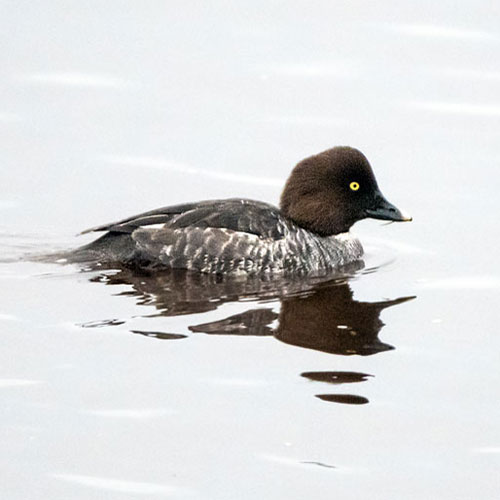 |
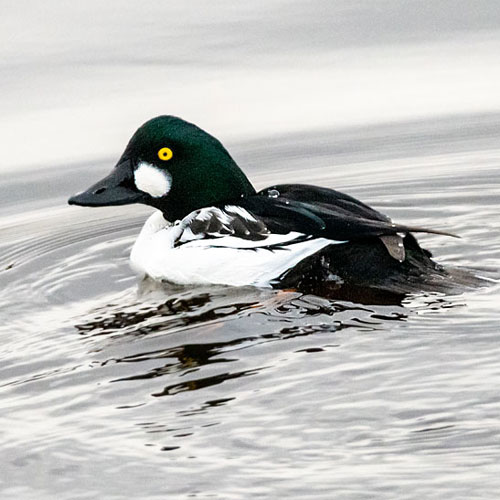 |
|
Cormorant |
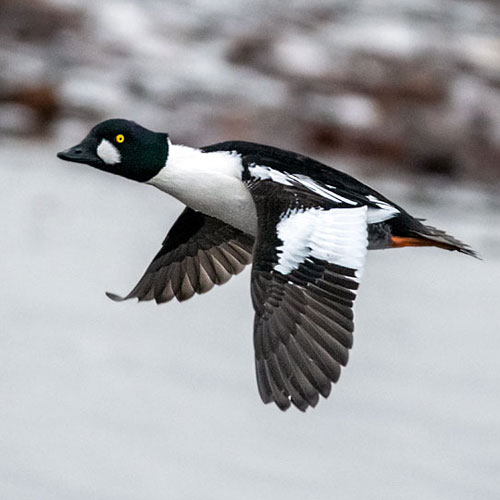 |
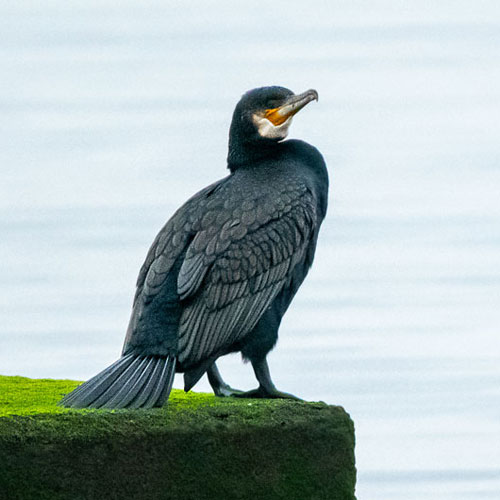 |
On the opposite side of the river there was a line of snoozing Redshanks and Turnstones on a
concrete wall which was soon to be submerged by the rising tide.
After I parked the car we planned to walk by the sea wall on our way to the first hide in the “new
scrapes”. The Esk mouth was very quiet apart from a few Turnstones and a few Rock Pipits. As
you might expect, with winter on the way, there were very few flowers to be seen around the
pathways, only Tall Melilot, Yarrow and Red and White Clover were still in bloom.
| Turnstone |
Rock Pipit |
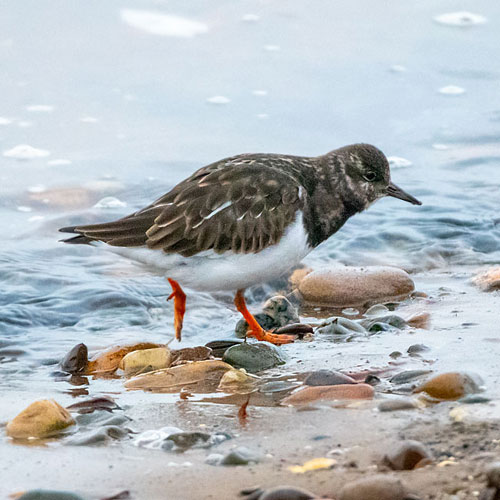 |
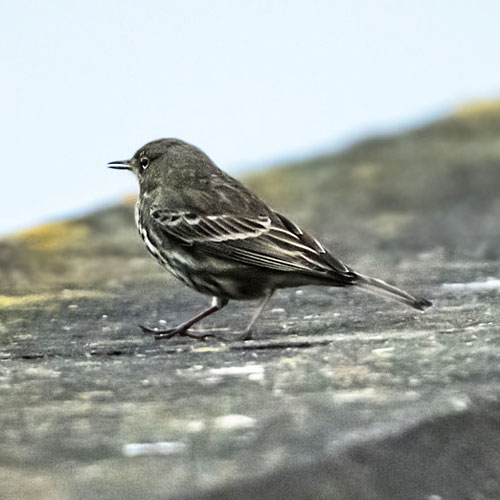 |
| Tall Melilot |
Yarrow |
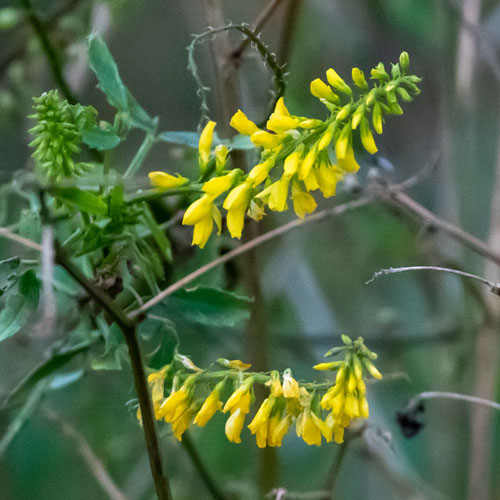 |
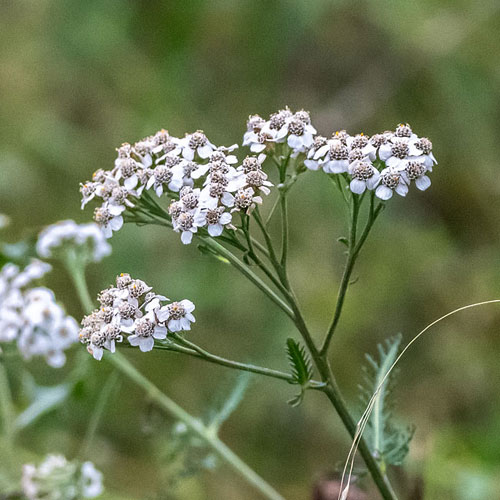 |
| Red Clover |
White Clover |
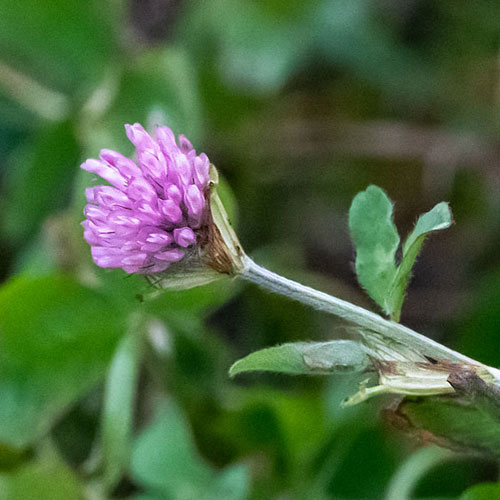 |
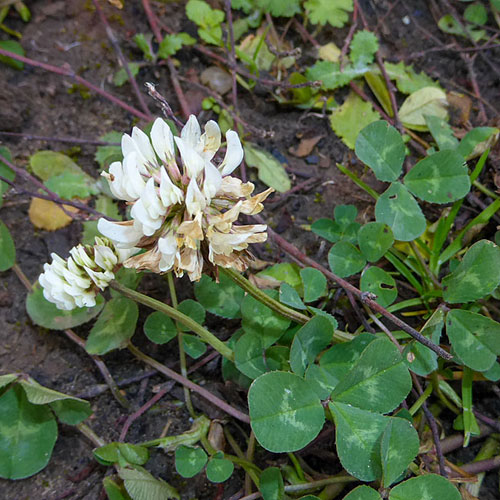 |
On entering the first hide we were treated to a flypast of 100+ Bar-tailed Godwits.
The Godwits circled the far end of the scrapes before settling there. We were so taken with that
spectacle that we missed a Grey Heron that was standing on a bank of the moat just in front of
us. Luckily I got a snap as it flew away when we inadvertently spooked it. There were lots of
Oystercatchers standing on the shingle and a rather distant Shelduck on the water. A lot
nearer was a juvenile Mute Swan that paddled past us on the moat.
| Bar-tailed Godwit |
Grey Heron |
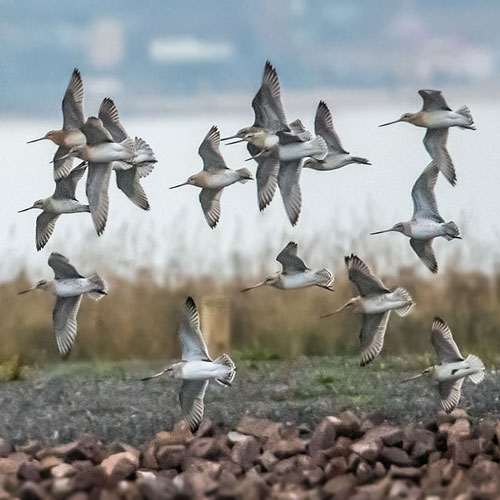 |
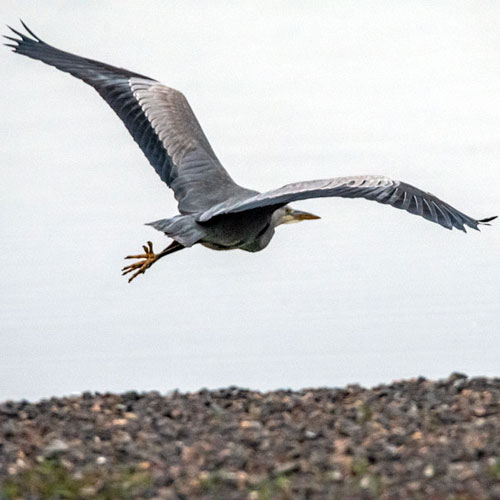 |
| Shelduck |
Juvenile Mute Swan |
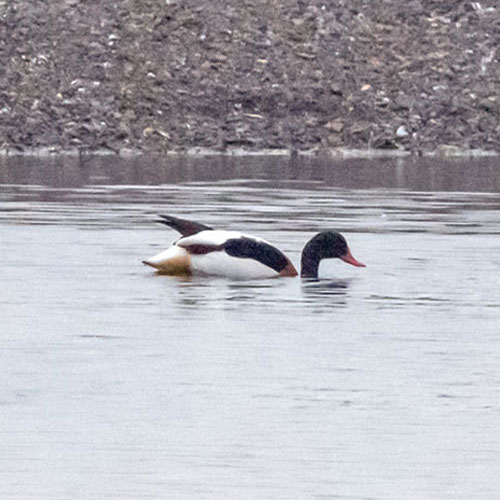 |
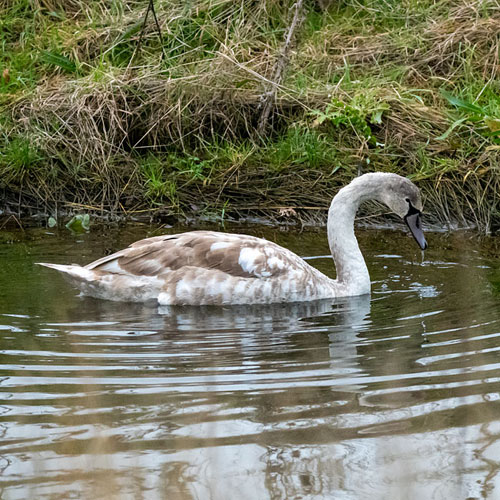 |
We moved to the next hide where we noticed Black-headed Gulls lined up on the far side of the
reserve.
A Greylag Goose and an adult Mute Swan were on the moat and a Redshank was treading along
the moat’s edges. John noticed a bedraggled female Mallard struggling to leave the moat. In our
short walk back to the car I snapped a Robin that was hiding in a hedge. We also passed a
Herring Gull that was “dancing for worms”.
| Greylag Goose |
Mute Swan |
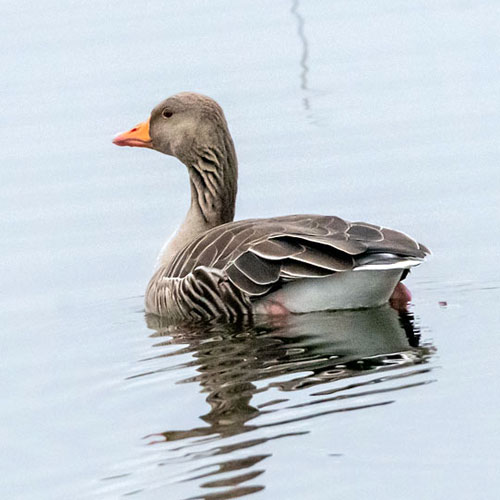 |
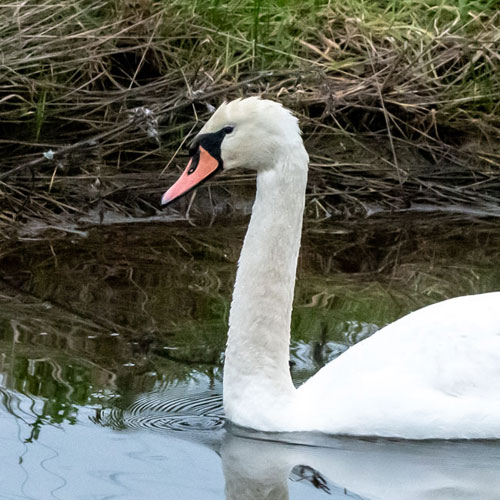 |
| Redshank |
Female Mallard |
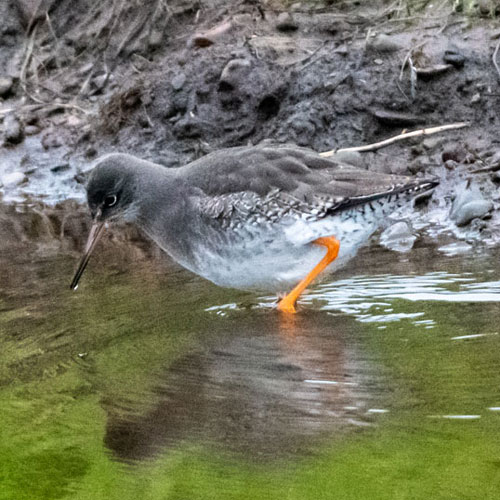 |
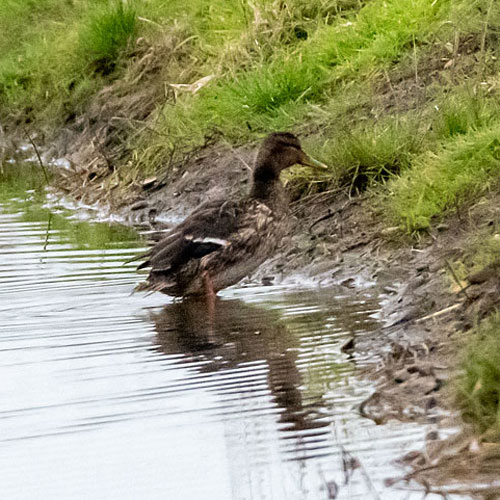 |
| Robin |
Herring Gull |
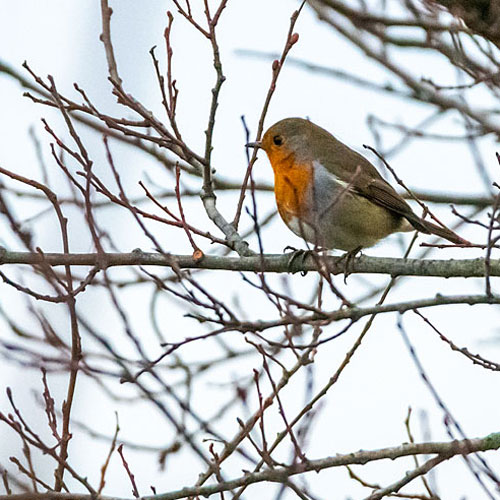 |
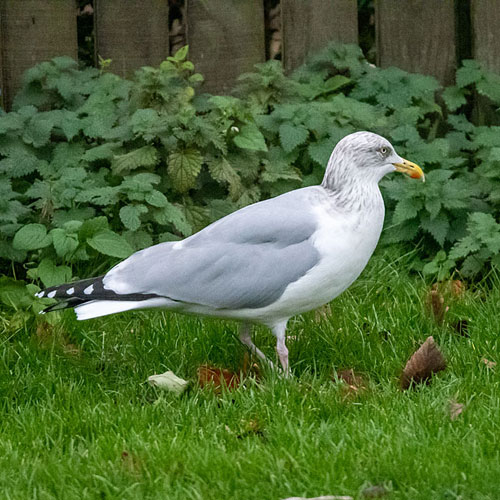 |
I drove around to the Levenhall Links car park, and from there we walked to the part of the
Levenhall Links Nature Reserve, known widely as “the Old Scrapes” (as opposed to the scrapes
we visited earlier, “the New Scrapes”). On the way, I manage a shot of a Blue Tit in trees by the
path. Inside the reserve, we started at the middle hide, but we were disappointed to find that most
of it had iced over. However our disappointment soon turned to joy when we realised that some
some of the birds that should have been on and around the water, were actually foraging on the
grassy areas in front of the hide. We were then pleased to see Redshanks, a Curlew and
Oystercatchers at close range. Slightly further away, between scrapes, a group of Wigeon were
feeding, and there was a pair of Roe Deer in the grass beyond the back scrape.
| Blue Tit |
Redshank |
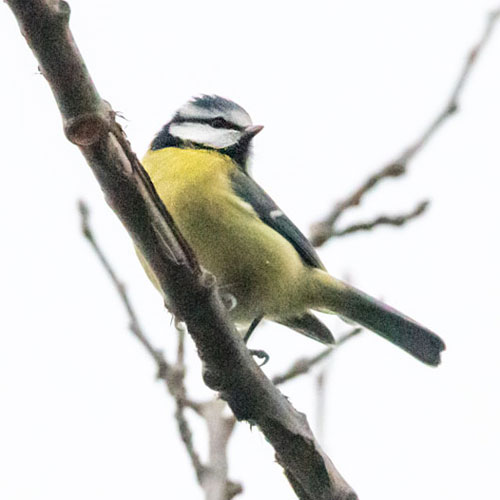 |
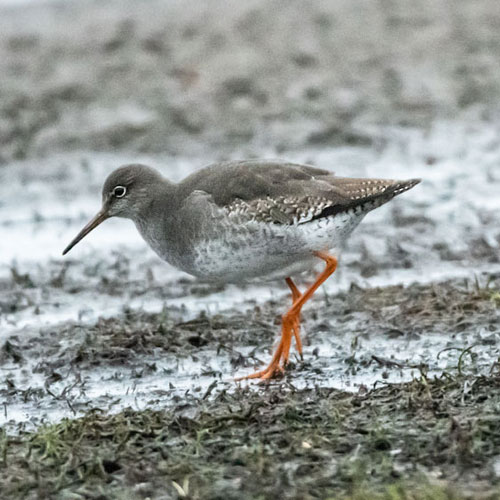 |
| Curlew |
Oystercatcher |
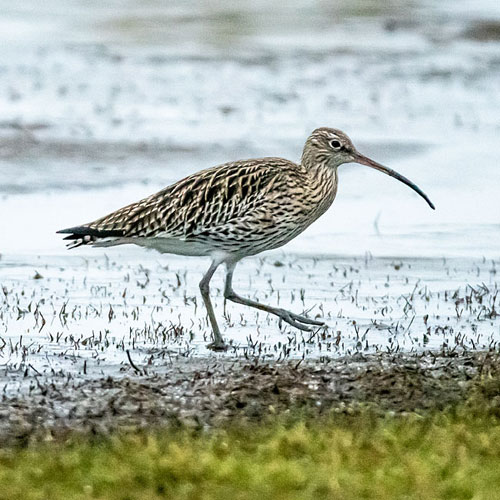 |
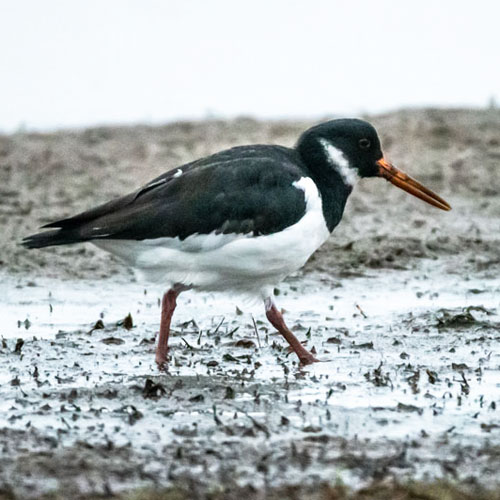 |
| Wigeon |
Roe Deer |
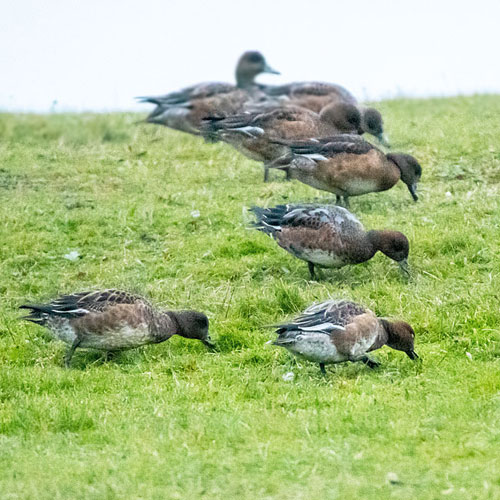 |
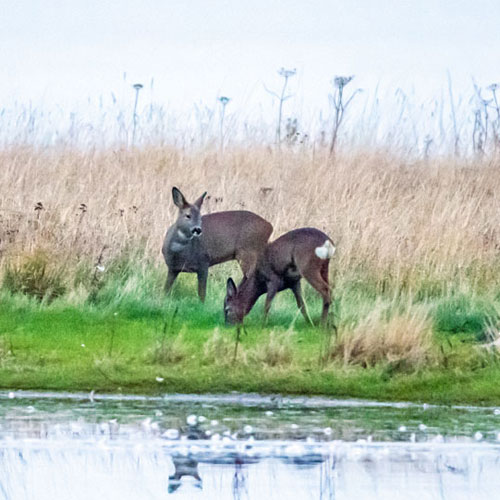 |
John scanned the right-most hide and scrapes with his binoculars. He was of the opinion that
there were Dunlin quite near the front of the right-most hide, and when we moved to there we
found that he was right.
There weren’t many other birds at the right-most hide apart from Redshanks skating on the ice, so
we relocated to the left-most hide. There we found that there was a multitude of birds that were
enjoying ice-free water. As I photographed Lapwings, a group of Wigeons flew in and joined the
Wigeons that were already on the scrape. The commotion seemed to have startled some
Common Snipe from their hiding places near the hide causing them to run towards the
scrape.
| Redshank |
Lapwing |
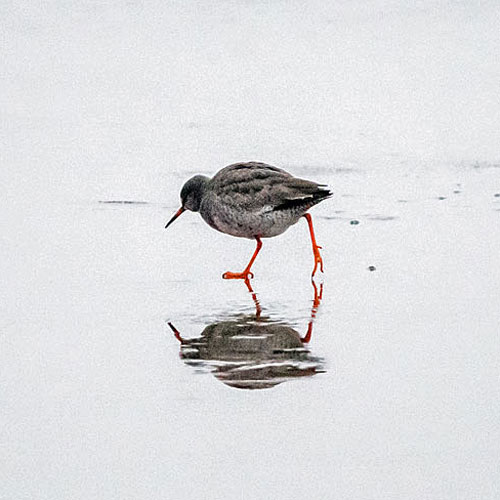 |
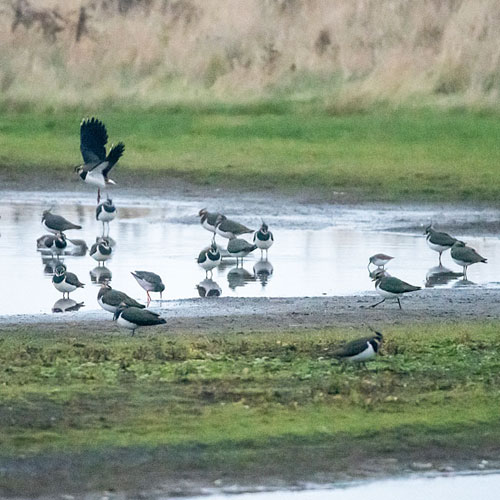 |
| Wigeon |
Common Snipe |
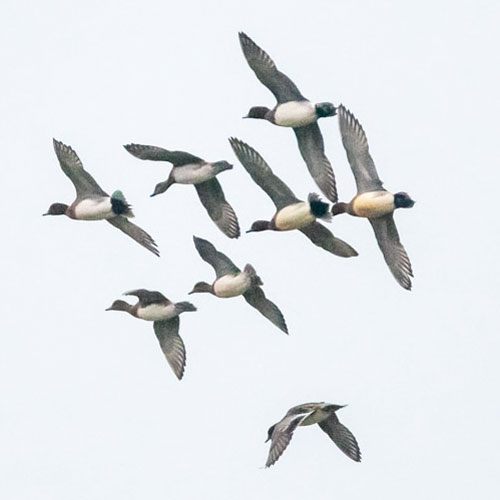 |
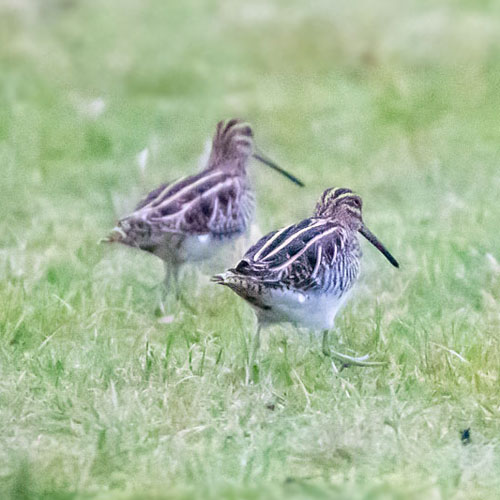 |
Meanwhile a fight broke out among the Wigeons, probably involving the recent arrivals.
Some Teal were caught in the middle of the fight but when it was over they resumed their
dabbling. Arriving late to the action was a mean-looking Curlew that descended onto the grass
near a Lapwing which stood exuding a couldn’t-care-less attitude. John then reported that he
had spotted an unfamiliar duck near the far bank of the scrape. I managed a record shot that
showed it was a winter plumage Long-tailed Duck . A Shelduck then left the water to stretch
its legs on the grass. Satisfied with our sightings at the scrapes, we returned to the car. Before I
started the engine John pointed out that the bushes next to the car were hosting 7 or 8 feeding
Bullfinches. I grabbed my camera and managed a few decent shots of them despite the poor
light.
| Teal |
Curlew / Lapwing |
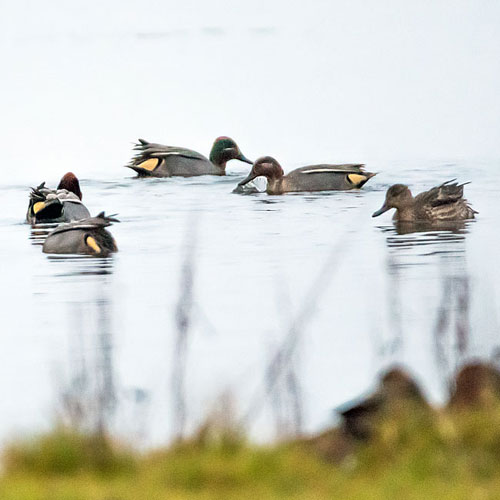 |
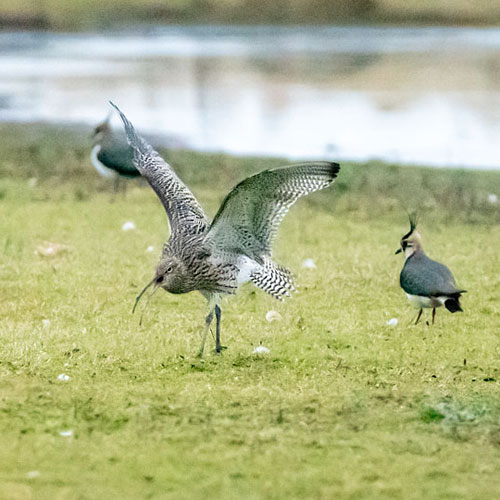 |
| Long-tailed Duck |
Shelduck |
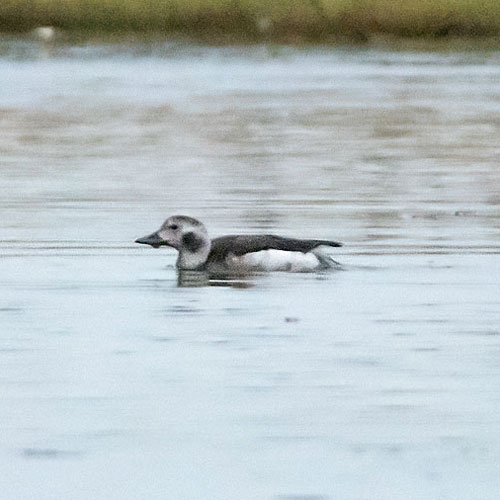 |
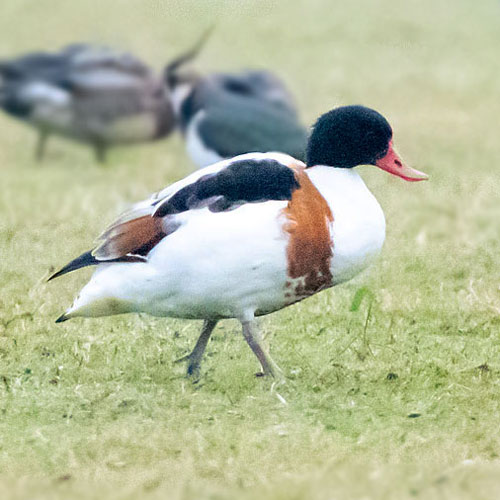 |
| Male Bullfinch |
Female Bullfinch |
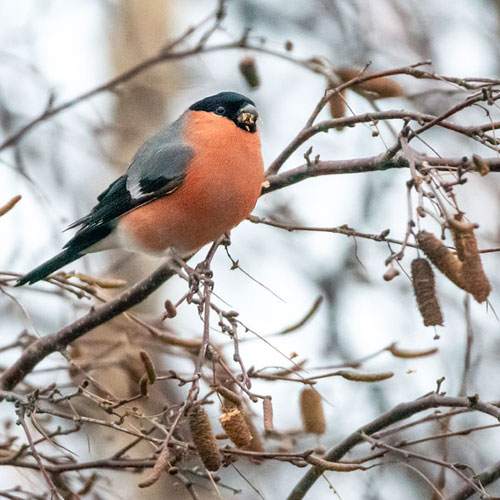 |
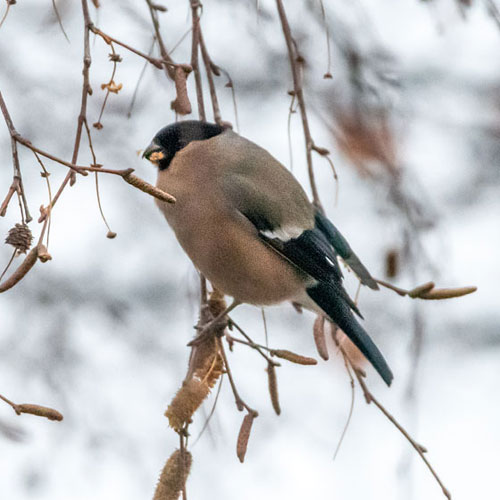 |
We moved to our final location, a few hundred meters east of the scrapes: Morrison’s Haven.
The light was worsening by the minute. However after a quick survey of the immediate coastline I
accumulated shots of Cormorants on the rocks, a White Wagtail nipping along the seawall and a
juvenile Red-breasted Merganser that was diving close to the wall, much closer than others in its
group. I followed that with a record of the Turnstones on rocks and seaweed piles. John then
completed his hat-trick of great spots with a sighting of a distant Slavonian Grebe.
| Cormorant |
White Wagtail |
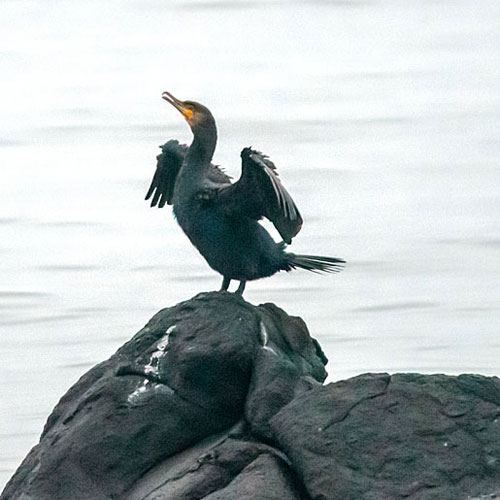 |
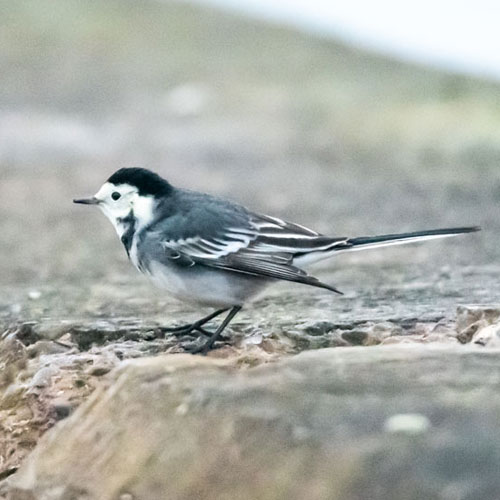 |
| Juvenile Red Breasted Merganser |
Turnstone... |
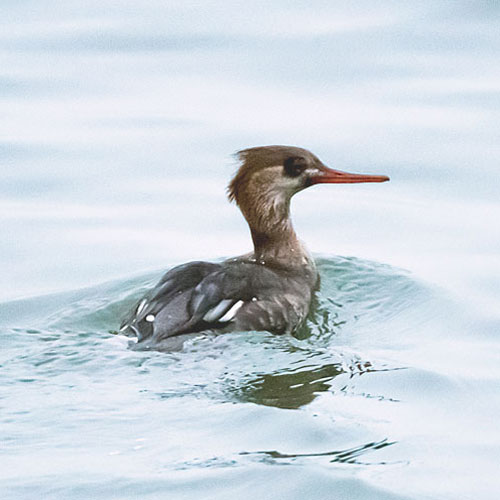 |
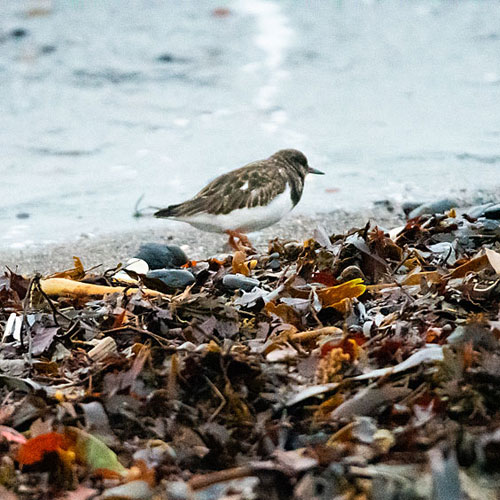 |
|
Slavonian Grebe |
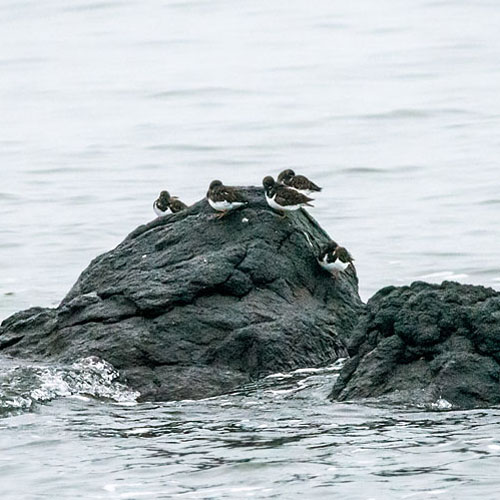 |
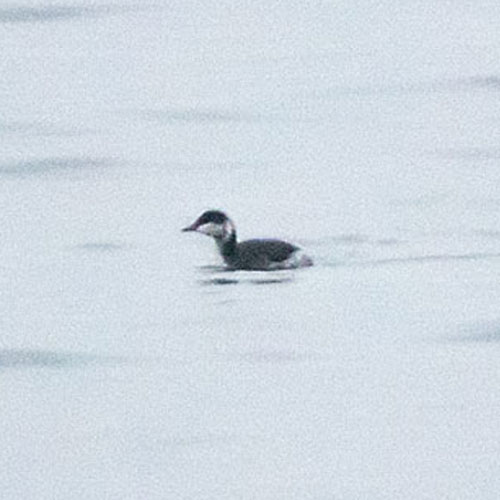 |
The trip was very enjoyable despite the dreich conditions. Of course we’d have liked glorious
sunshine, but we were thankful it didn’t rain. We saw plenty of birds and my favourites were the
Goldeneyes, Godwits, Snipe and Shelduck and it was nice to see the Long-tailed Duck and
Slavonian Grebe. We enjoyed our teas and strawberry tarts in a gloomy Morrisons Haven car park.
Creatures of habit we are
Week ending: 19th November 2023: Barns Ness
With my WeatherPro app predicting that Sunday’s weather for Central Scotland would be cloudy
in the west and sunny in the east, it was a simple decision to head for Barns Ness, which we last
visited 10 weeks ago. The only slight downside to this was that the tide would be very low during
our visit, and hence the sea birds would generally be quite far from the footpath.
Of course, our first activity of the day was to visit Dalkeith Morrisons for our usual small
breakfasts (9/10: very good, but -1 for overcooked bacon).
On arrival at the Barns Ness car park, the Sun was out and so was the tide. We began our circuit
of the site on the damp, rocky bay in front of the car park, which seemed birdless at first, but after
a few minutes, we realised that there were quite a few birds foraging in the rock pools and soft
mud. Before too long I had photographs of Oystercatchers, Carrion Crows and a distant Grey
Heron, spotted by John.
| Oystercatcher |
Redshank |
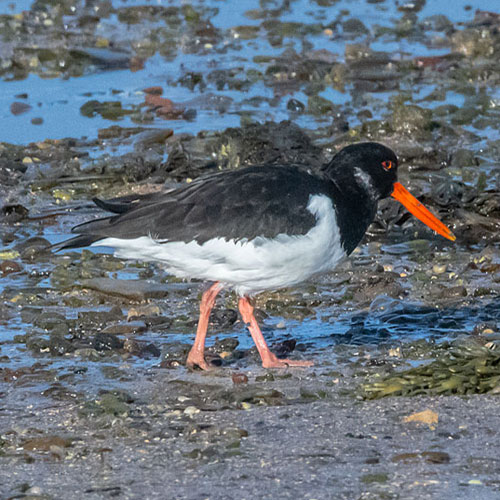 |
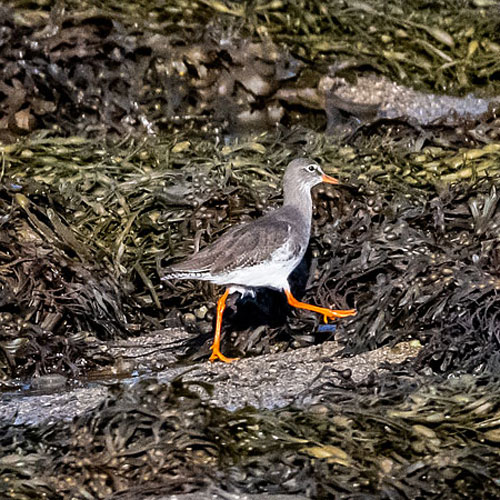 |
| Carrion Crow |
Grey Heron |
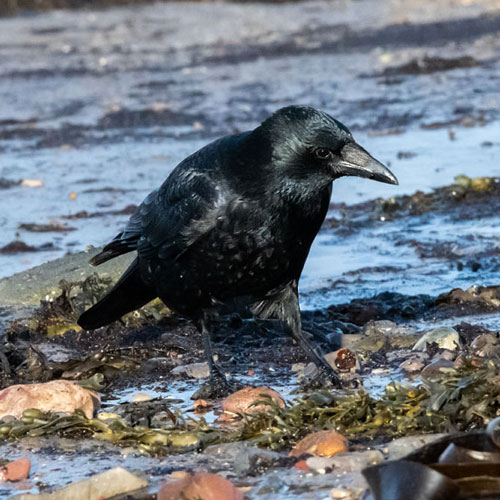 |
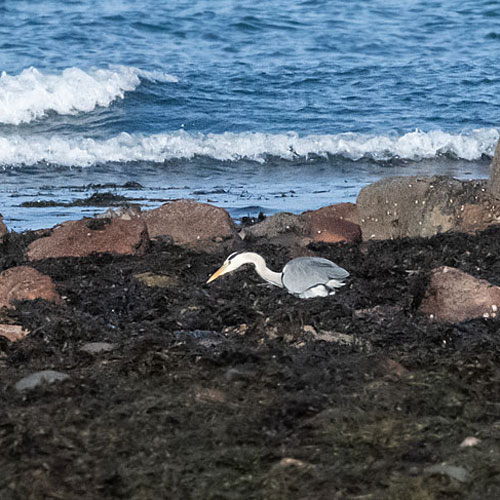 |
I noticed a Common Gull that was sitting on a rock overlooking a feeding Curlew. Probably the
gull was eyeing-up whatever the Curlew was feeding on. John then pointed out a few Rock Pipits
that were fluttering about the shore. A Little Egret came into view about 100 m from us and
soon after that, a second Little Egret was spotted about 50 m to the west. As we passed the
lighthouse, a Curlew flew past carrying a crab in its beak. Unfortunately it landed behind a rock,
out of view. We next cast our gaze into the blue sky when, high over our heads, a large flock of
Golden Plovers circled for a short time before vanishing to the east. At the other side of the
lighthouse we were pleased to see a Stonechat that was surveying the grassland from the
top of a leafless bush.
| Common Gull |
Rock Pipit |
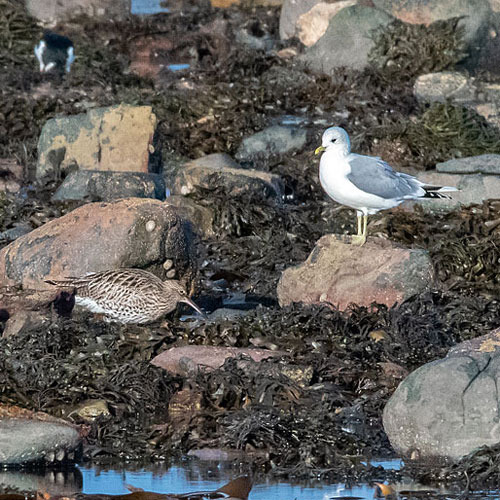 |
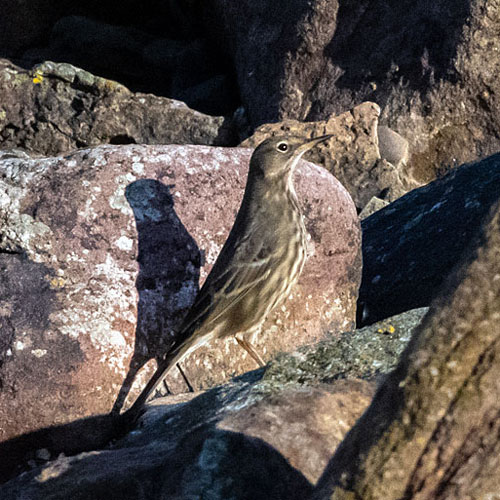 |
| Little Egret |
Curlew |
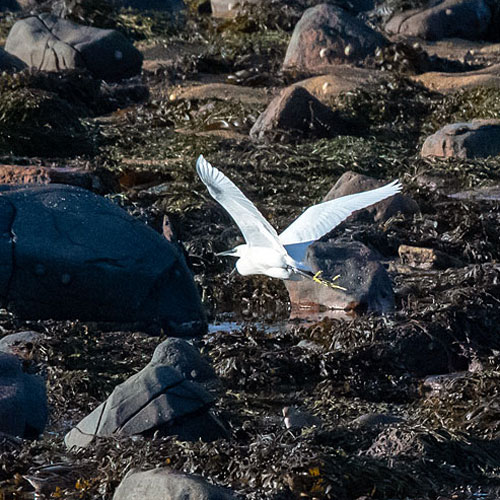 |
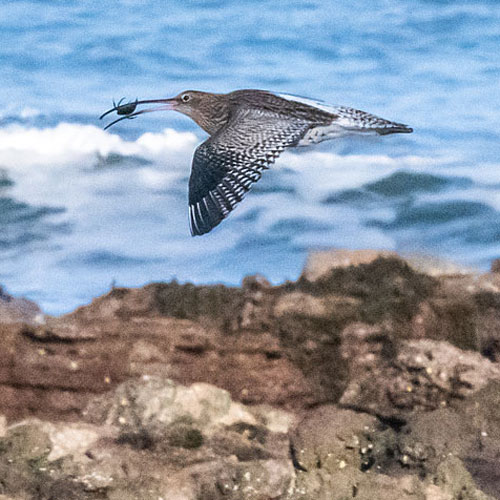 |
| Golden Plover |
Stonechat |
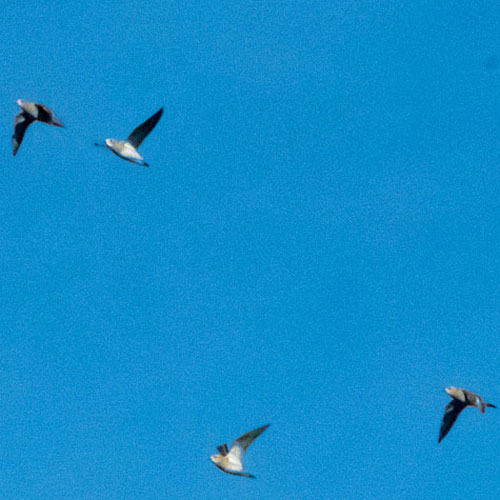 |
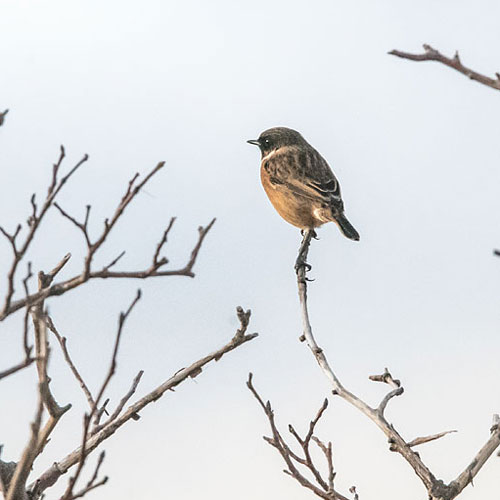 |
Below is the view of the lighthouse. The Stonechat was in the field to the left of the path.
We walked along the path by the field and eventually were able to access the extensive beach.
Unfortunately the sky had clouded over but while we sat on the beach we heard, and then saw a
flock of over 100 Greylag Geese flying over the open-cast excavation that is south of the
Ness. Sadly they were silhouetted against the grey sky, but I managed to process a shot to show
the familiar markings of the Greylags. After a few minutes sitting on our wee 3-legged stools, by
the sand dunes, Redshanks and Starlings reappeared to feed on the piles of seaweed that was
washed up on several areas of the beach. Then, much to our surprise, a Little Egret descended on
the rocky shore only about 40 m from where we were sitting. It foraged about for a bit (note the yellow
feet) and then flew off to the east.
Looking along the horizon one cannot miss the huge wind turbines now generating electricity from
The Neart na Gaoithe Offshore Wind Farm.
As we continued our observations from our stools I photographed several flypasts of Curlew,
Starlings, Oystercatchers and Herring Gulls chasing Carrion Crows.
A flock of around 50 Sanderlings flew in from the east and settled at the water’s edge which
was about 100m from where we were sitting.
Because they were so far away and so small, the Sanderlings were difficult to see when they were
standing on the shore but were fairly easy to see when they flew in a group. Close to them there
was a bird that puzzled us at first, but turned out to be a female Eider. No problems though when
observing the distant but familiar pose of the Cormorant with outstretched wings or the large and
ubiquitous Grey Heron. Nor did we have troubled identifying the tiny Pied Wagtails and Linnets that were right in front of us on the seaweed piles.
| Sanderling |
Female Eider |
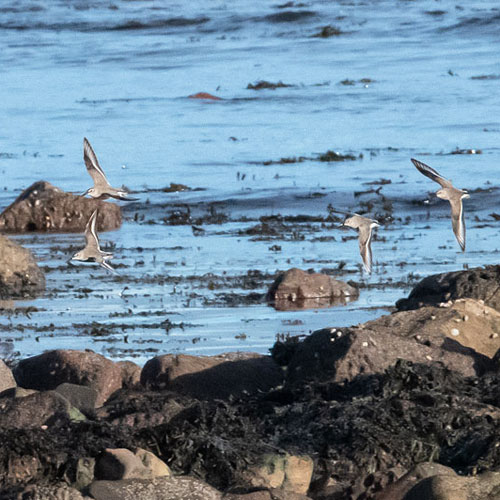 |
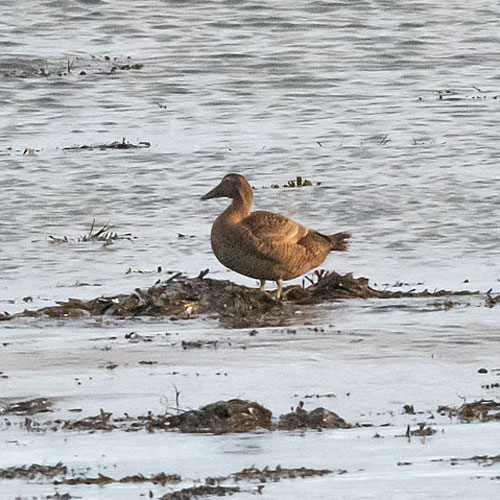 |
| Cormorant |
Grey Heron |
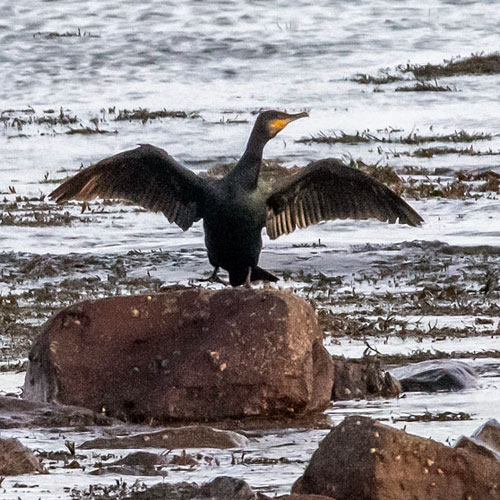 |
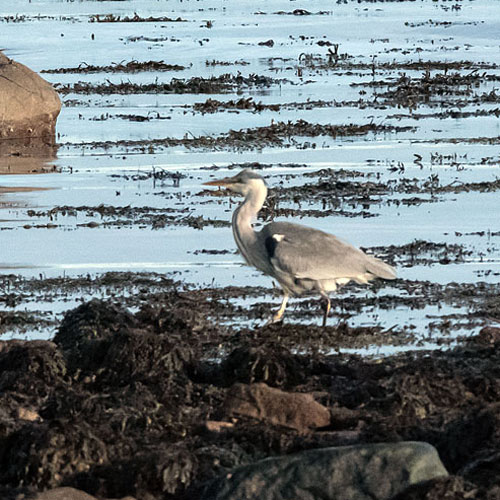 |
| Pied Wagtail |
Linnet |
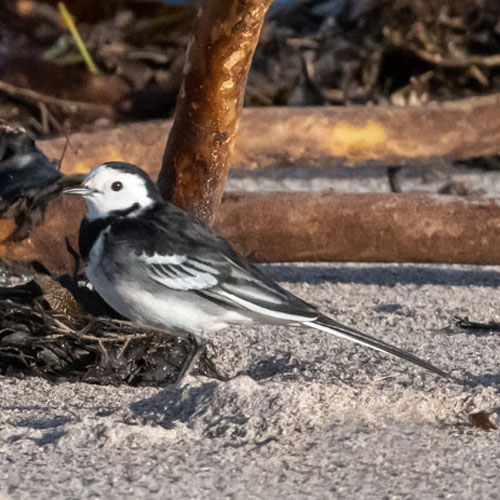 |
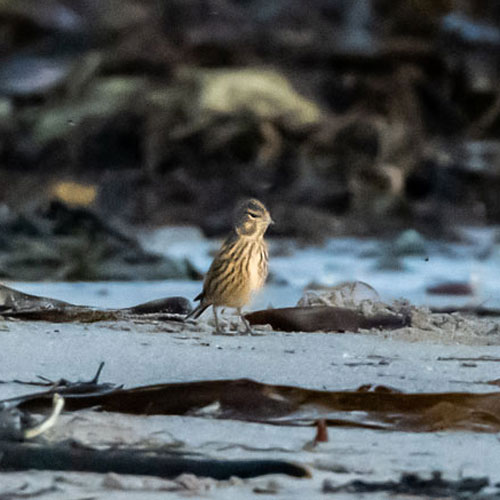 |
As the sky darkened we headed back to the car via the southern boundary, through the old
caravan park. On the way I was on the lookout for any wildflowers but all I managed was a few
Common Daisies and some yellow Gorse. A Yellowhammer kept an eye on us near the
boundary wall and, very obligingly, posed calmly as I snapped away. We stopped briefly where the
wall meets the conifer wood and I came across some Grey Knight fungi growing through the
short grass.
| Common Daisy |
Gorse |
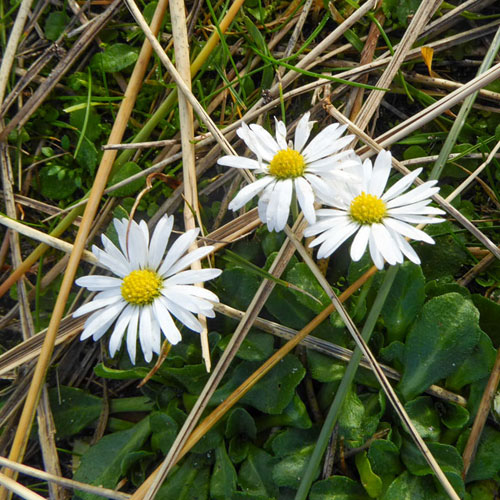 |
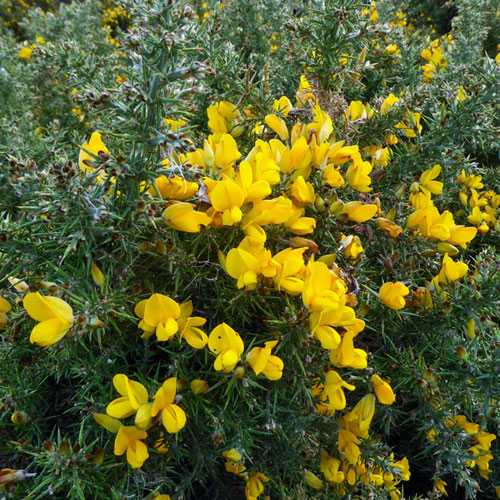 |
| Yellowhammer |
Grey Knight |
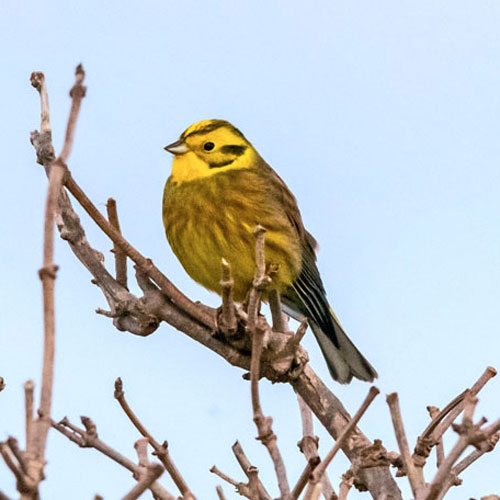 |
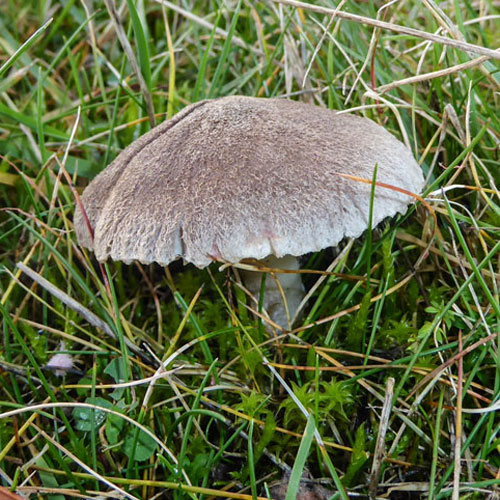 |
John spotted a hybrid Carrion X Hooded Crow sitting on conifers by the boundary wall.
Shortly after that, John noticed a pretty and solitary Harebell that was partially hidden by grass.
He suggested it would make a nice shot. We finished at the old caravan park with a very pleasing
shot of a Kestrel that flew in from the shore onto trees beside the derelict caravan park. Our
final sighting was of a noisy and nervous flock of Goldfinches that were assembled on the top
branches of a tall and leaf-less tree.
| Carrion x Hooded Crow Hybrid |
Harebell |
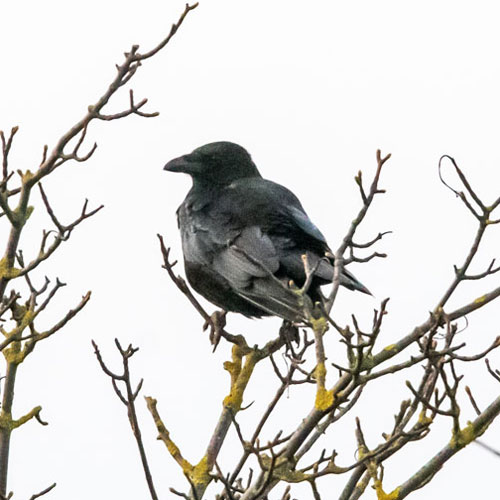 |
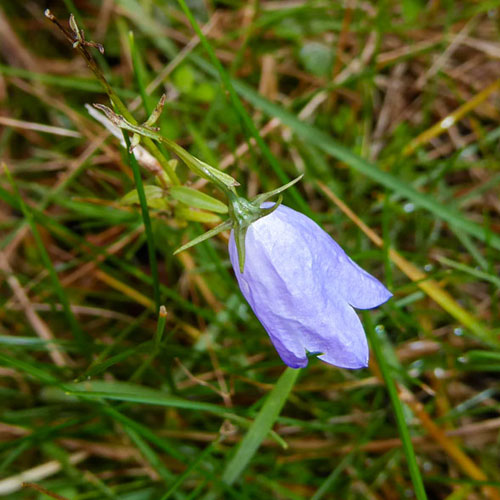 |
| Kestrel |
Goldfinch |
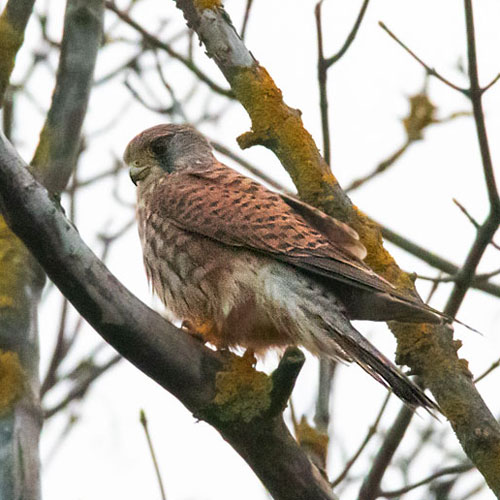 |
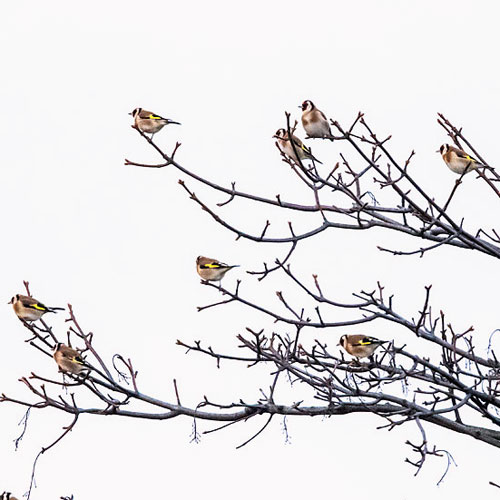 |
As we approached them they fled from the tree onto telephone cables above the car park
approach road. From there they flew into the trees on which we saw the Kestrel.
This was a visit that started quietly but, despite the clouds rolling in, kept giving us nice surprises
such as Little Egrets, Golden Plovers, Greylags, Sanderlings, Yellowhammer, Kestrel and
Goldfinches. Before driving home we took our tea and strawberry tarts with a sense of
satisfaction. The weather has been mild for the time of year but much colder weather is predicted
for next week, so it looks like we may be needing our thermal underwear next Sunday
Week ending: 12th November 2023: Belhaven Bay, Dunbar Harbour and Port Seton
My nature-watching exploits started a day early this week, when, on Saturday, over 100 beautiful
and hungry Waxwings descended on rowanberry-rich Silver Birch trees in Mossend, North
Lanarkshire. I therefore joined a large group of like-minded people with with big lensed cameras
to fill my camera with images of these very photogenic fliers, the best of which are shown below.
A few passers-by enquired as to what all the fuss was about, and I explained that these were
infrequent visitors from Scandinavia, rather confusingly called “Bohemian Waxwings ”, since
Bohemia is an historical region of the Czech Republic. However the term “bohemian” implies
“wanderer”, which does seem a relevant term for these birds.
On Sunday, the weather was to stay sunny longest in the east, and since a visit to Dunbar was
overdue, I chose there. Unfortunately John was not able to join me, but nevertheless I headed for
Dalkeith Morrisons and enjoyed a very nice breakfast before driving down the A1 to the Shore
Road car park in Belhaven.
The tide was steadily rising in Belhaven Inner Bay but it was shallow enough for waders such as
Curlew, Oystercatchers and Redshanks. Also, about 20 Wigeons were dabbling in the
deepening waters and some birds were flying nearer the sea wall, including a Rook that passed
above me cawing loudly. Making a good deal more noise than the Rook was an aeroplane doing
aerobatics above the Bay. Thankfully it left fairly quickly.
| Curlew |
Redshank |
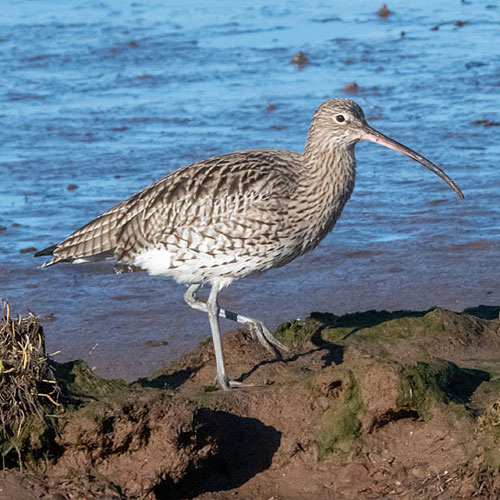 |
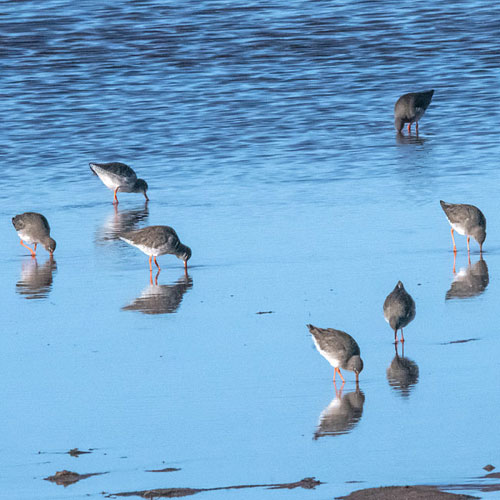 |
| Oystercatcher |
Wigeon |
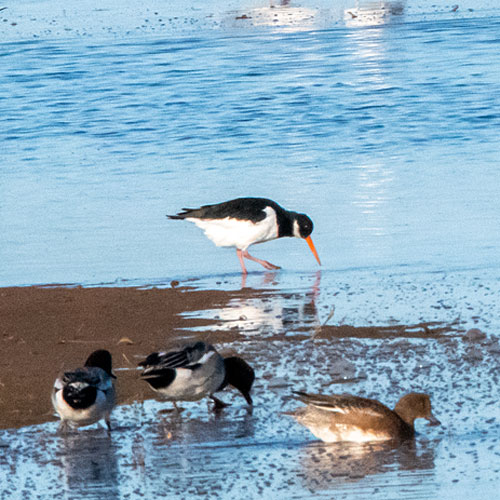 |
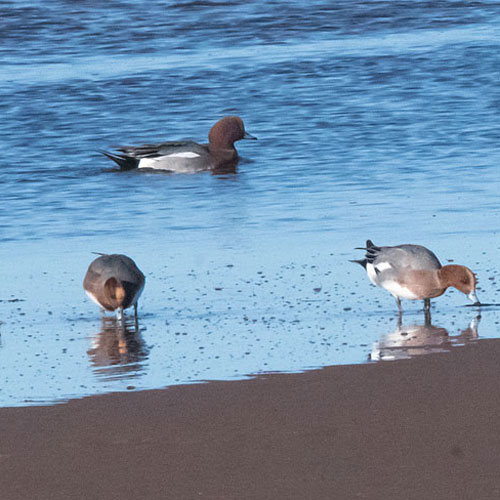 |
| Rook |
|
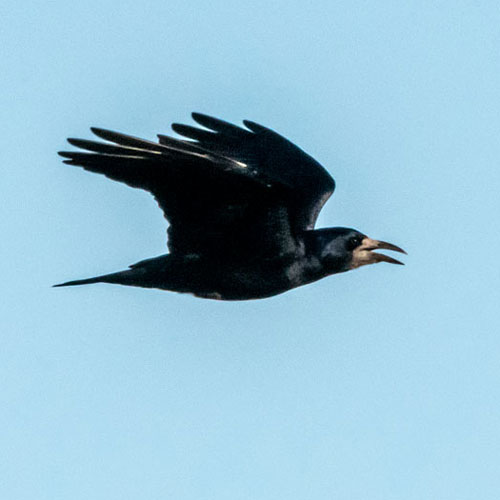 |
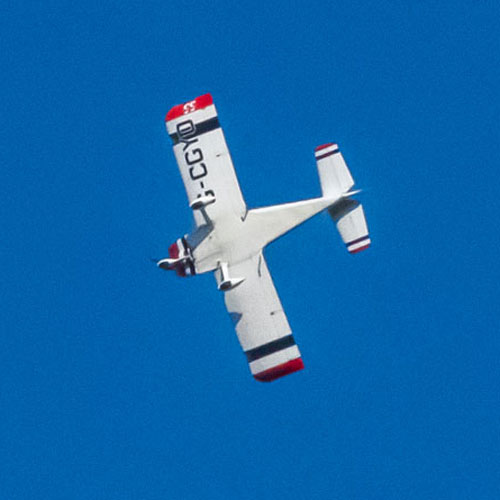 |
Below is the view over Belhaven Inner Bay looking towards the Bass Rock. Note the surfers, of
which there were many across the whole site.
A family of Mute Swans were on the grass at the start of the pond area. A few Mallards were there
also, but a large number of Wigeon were dominating the scene as they nibbled the grass. I walked
past them carefully and, from a safe distance, I turned and fired off a few shots. I continued until
the inevitable unleashed dog stormed in causing the birds to take to the water. In the mix on the
water I spotted two juvenile Wigeons.
| Mure Swan |
Mallard |
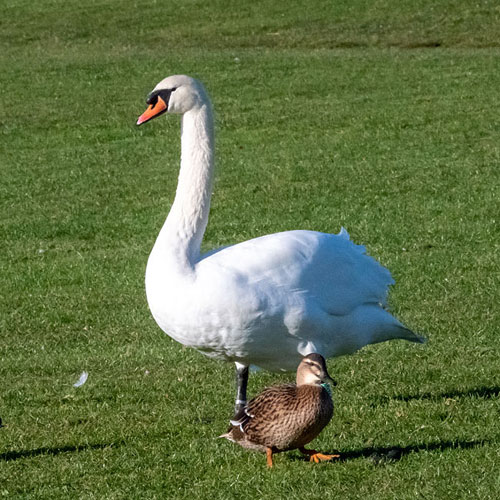 |
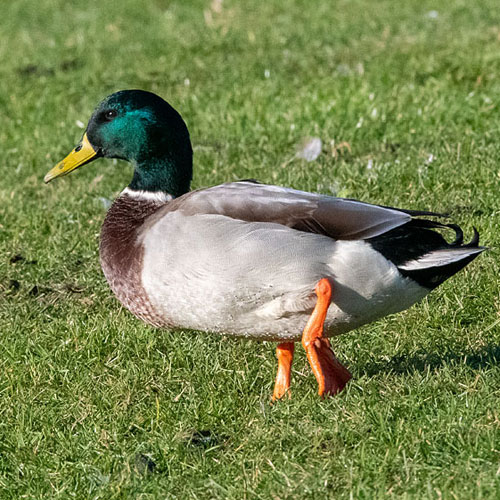 |
| Wigeon |
Juvenile Wigeon |
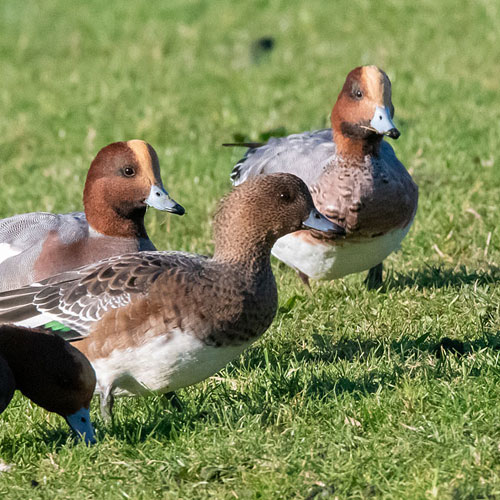 |
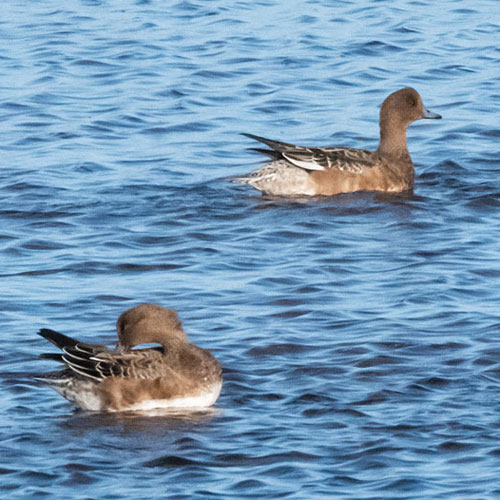 |
I walked around the pond perimeter towards the southern end. A few Tufted Ducks , as well
as Coots, were on the middle of the pond. At the southern-most end of the pond I noticed a
couple of feeders upon which some Blue Tits were pecking at the peanuts. A few Teal were
resting at the water’s edge, soaking up the sunlight.
| Tufted Duck |
Coot |
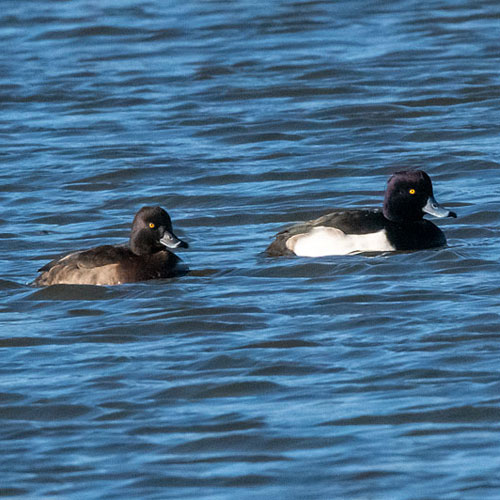 |
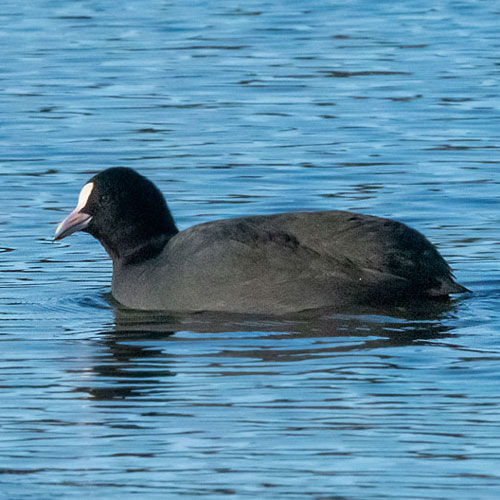 |
| Blue Tit |
Teal |
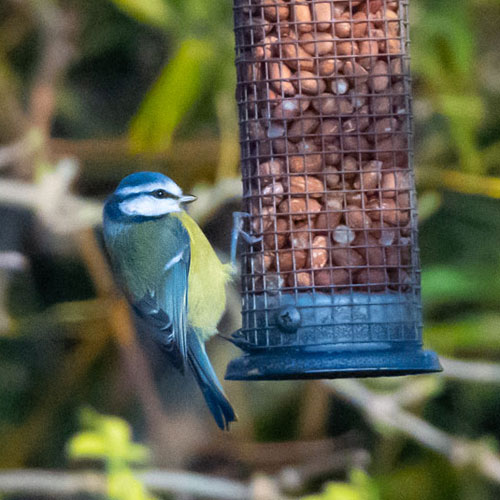 |
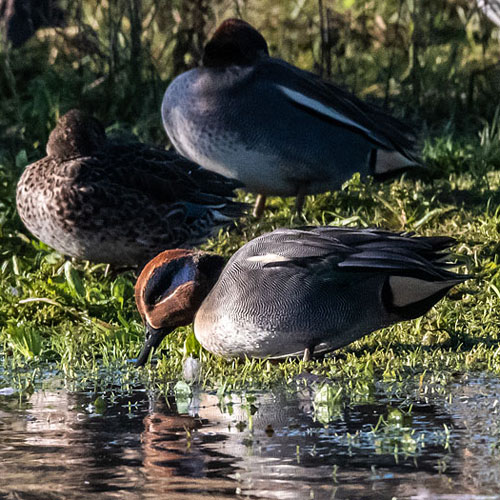 |
I found a parking space at Dunbar Harbour and walked around the perimeter. The view from the
Battery showed the stiff breeze and choppy sea pounding the little islands to the north. I suppose
the Gulls, Cormorants and Shags were probably lapping it up.
There wasn’t much bird action to be seen from the harbour walls, but there were Herring Gulls in
the harbour basin and I snapped a wee Wren that was nipping around the stacked lobster creels.
A pair of young Herring Gulls were in a dispute over what looked like a small fish.
| Herring Gull |
Wren |
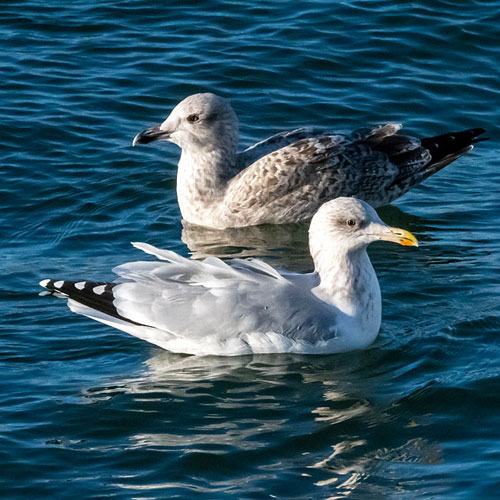 |
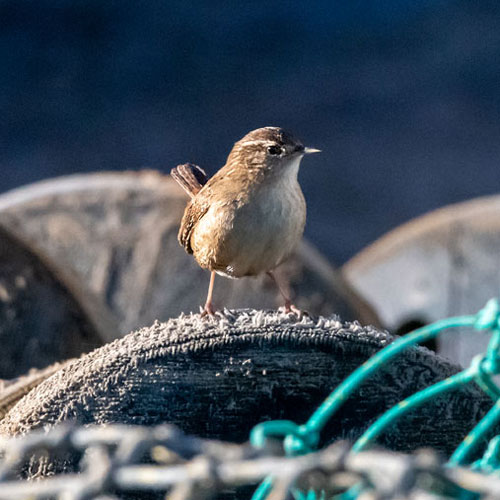 |
| 3rd Cycle Herring Gull |
1st Cycle Herring Gull |
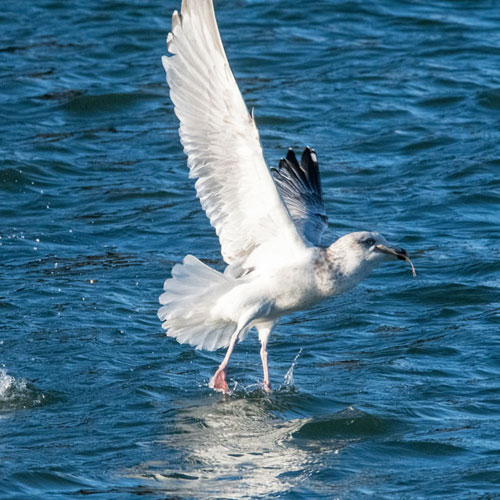 |
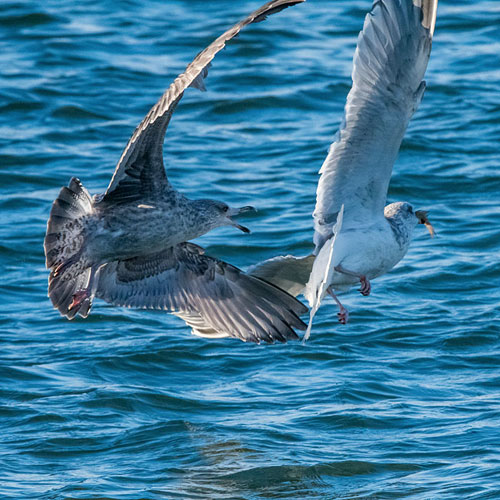 |
A couple of small fishing boats chugged into the harbour - which left me wondering , nay, hoping
if a Seal would follow them in.
I was delighted then, when a big Grey Seal surfaced right in the centre of the harbour basin. It was
too bad for “Sammy” that the boats had passed into the deeper recesses of the harbour, probably
inaccessible to it. However the Seal hung about posing for a time before vanishing beneath the
surface. A lovely wee Tabby cat appeared beside me probably looking for a tit-bit, but I decided to
head for Port Seton. However soon after leaving the harbour car park, I stopped briefly to take a
picture of the view over Belhaven Bay looking towards the Bass Rock.
On arrival at Port Seton I parked at the Wrecked Craigs and was disappointed to see no rocks,
only water. However when I walked up to the sea wall barriers I saw that there were
Oystercatchers, Redshanks and Turnstones feeding furiously on piles of seaweed, out of east
view just below the seawall. As I photographed these, a Rock Pipit appeared on the seaweed.
Also I heard, from behind me, the familiar cheeps of a Pied Wagtail. I was, at first, pleased to see
a female Eider sitting on the seaweed. It was only when I looked at the photo that I saw she
was injured.
| Oystercatcher |
Redshank |
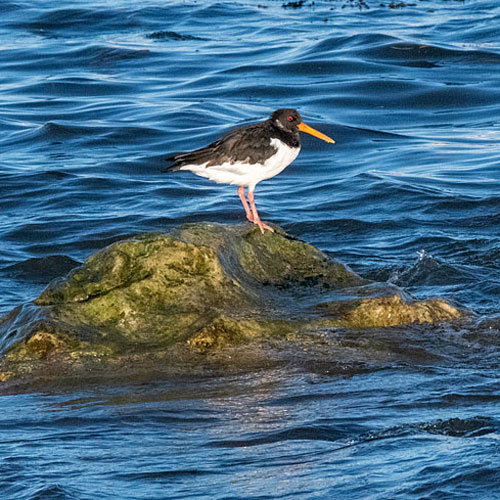 |
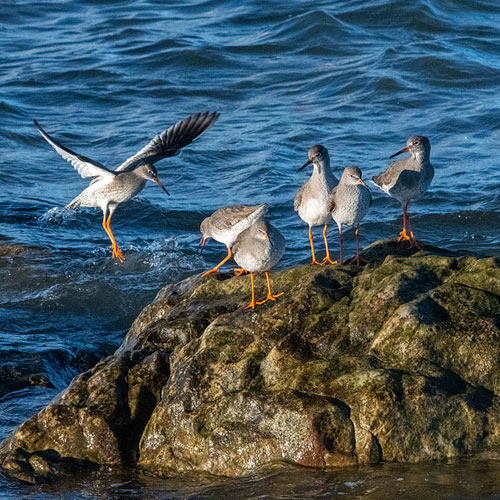 |
| Turnstone |
Rock Pipit |
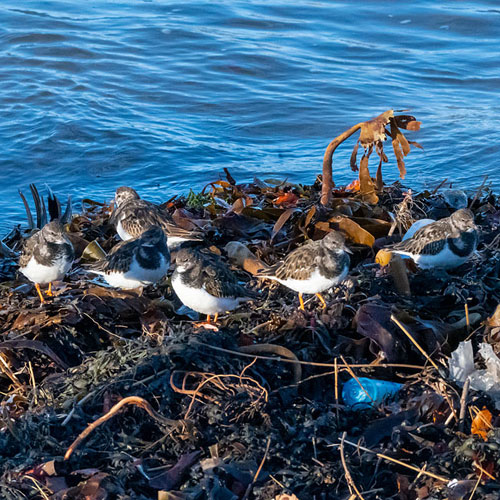 |
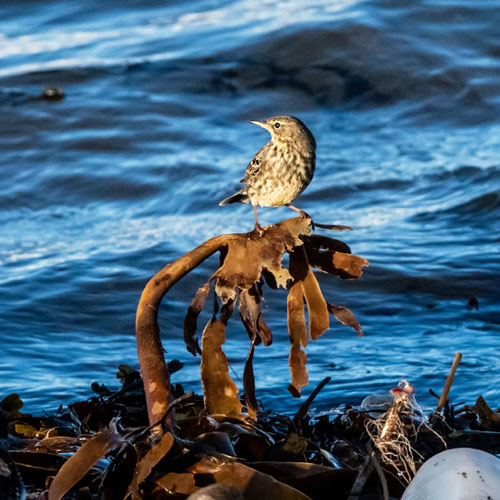 |
| Female Pied Wagtail |
Female Eider |
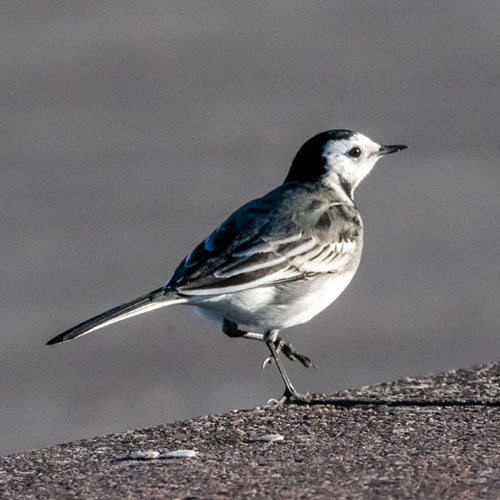 |
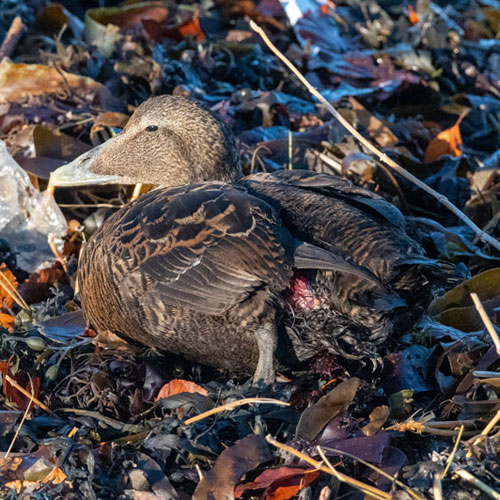 |
A small group of Eider paddled passed, but the injured Eider didn’t join them. I walked toward the
harbour and found more birds: Turnstones, Oystercatchers, Redshanks and another Rock
Pipit feasting on and around another seaweed pile.
| Drake Eider |
Female Eider |
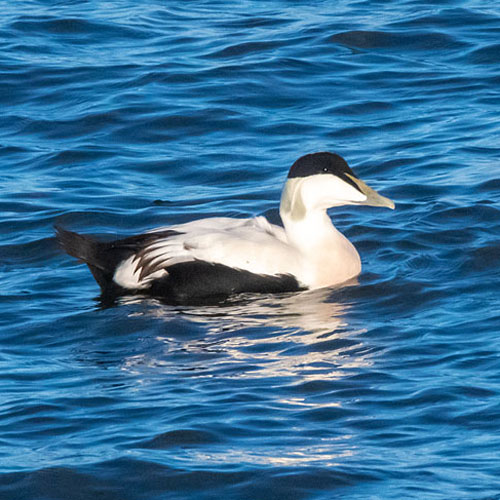 |
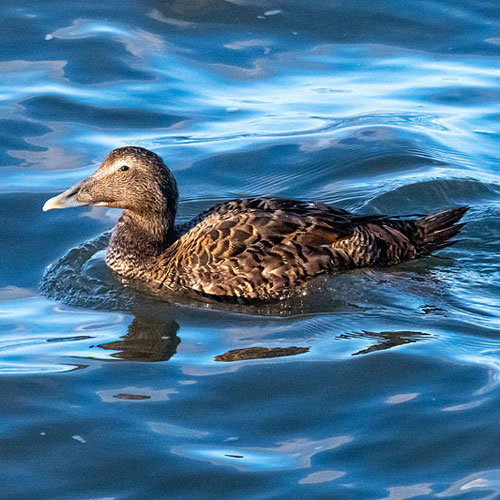 |
| Turnstone |
Redshank |
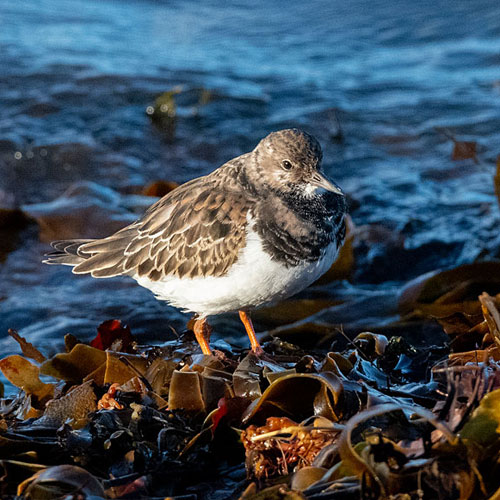 |
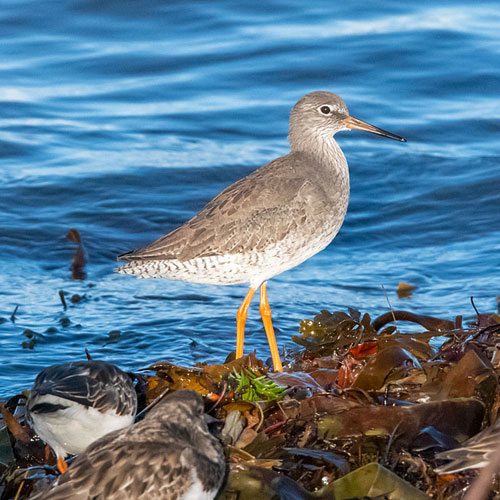 |
| Rock Pipit |
Oystercatcher |
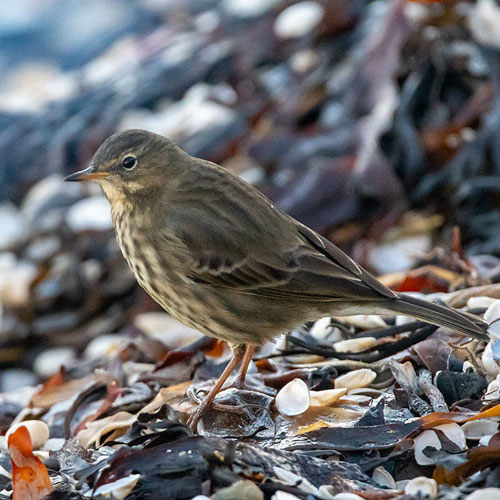 |
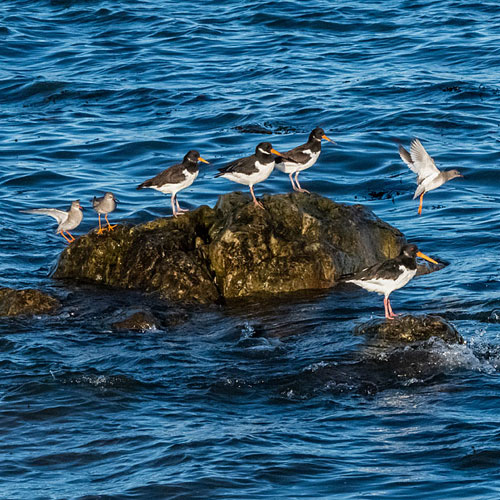 |
After the excitement of photographing the Waxwings on Saturday, Sunday’s visit seems a bit “run
of the mill”. However, on reflection, it is always satisfying seeing any seabirds, especially under
blue skies. I enjoyed watching the Grey Seal in Dunbar Harbour and my close encounter with the
Wigeons at Seafield. I had a wee chocolate biscuit and a cup of strong tea before returning home.
Hopefully next week will bring further nature-watching excitement - and more blue skies
Week ending: 5th November 2023: Ardmore Point
Dull and rainy conditions were predicted for Sunday at both the Lothian coast and the Ayrshire
coast. However, rather unusually, dry, sunny weather was predicted for Dumbarton, more
specifically, Ardmore Point, Cardross. So after breakfast in Dumbarton Morrisons cafe (5/10: very
poor. Food cold, uncleared tables, damp floor (I could go on)), that’s where we went.
On arrival at the Ardmore parking area, the tide was high and the sky was overcast. Normally
these would be signs that we were in for an unproductive visit so we were pleasantly surprised
that we had accumulated nearly a dozen sightings within the first 100m of our usual circuit around
the Ardmore peninsula.
I started snapping at the bird feeder outside the cottage at the entrance to Ardmore House where
we saw a Coal Tit and a Blue Tit tucking into peanuts. There was a Robin on the eaves of the
cottage and we could see lots of Greenfinches in the nearby trees. A female Greenfinch
conveniently descended onto the tall grass and there was a Goldfinch lurking in a low bush. A
large Starling flock were feeding on the foreshore but as we reached them a dog spooked them
into a tree. John spotted a Great Tit briefly checking if the coast was clear.
Next we came across more Greenfinches, a male and a juvenile. Also I got a Blue Tit in my
viewfinder and the resulting image caught it just as it took off from its tree branch. John then
noticed activity in the neighbouring field where a small flock of feeding Oystercatchers were
disturbed by a passing helicopter.
| Greenfinch |
Juvenile Greenfinch |
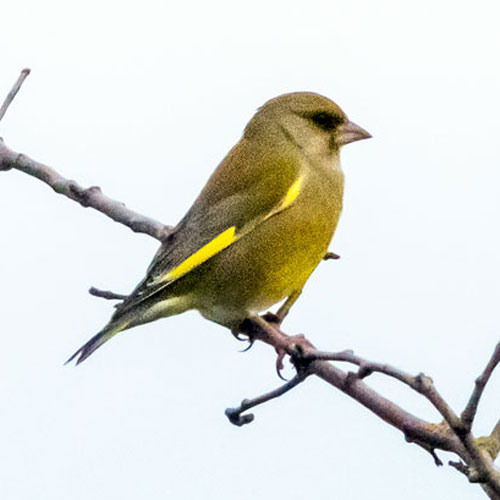 |
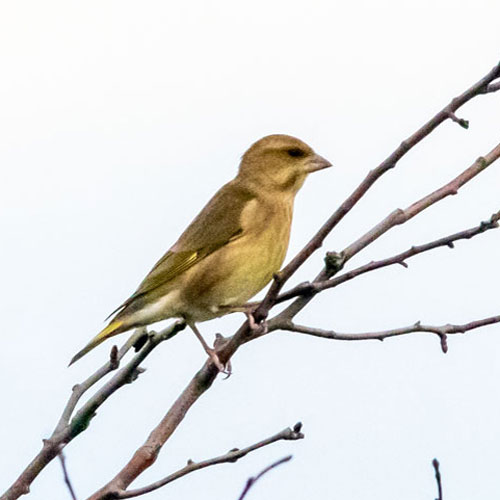 |
| Blue Tit |
Oystercatcher |
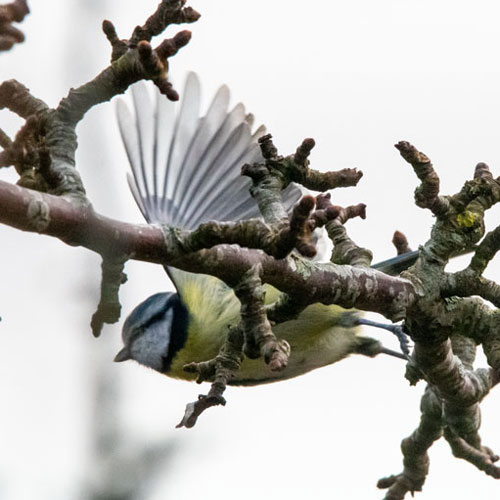 |
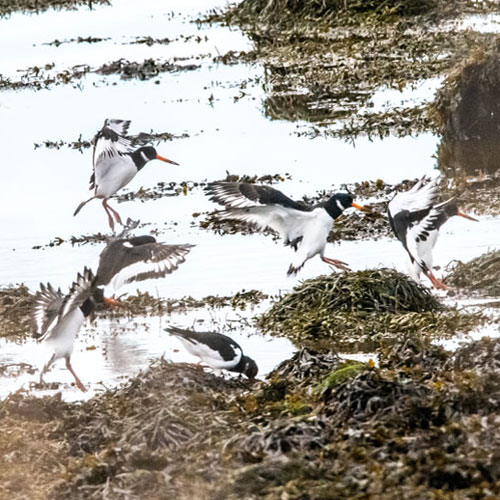 |
There were also some Curlew in the field and a large number of Canada Geese in the next field.
While I was photographing them, John excitedly, declared that a beautiful Little Egret was
flying towards us along the coast. It landed briefly about 50 m from where we were sitting.
Although we had photographed Little Egrets before, we had never seen them at Ardmore. We
continued along the path pausing to photograph a Pied Wagtail on the rocks, and an inquisitive
Robin perched in a low bush.
John’s binoculars then picked up a flying line of around 20 Whooper Swans quite a
distance to the east.
We’d a much closer flypast when a big Grey Heron flew in and landed at the water’s edge. That
was followed by a flypast of a trio of Mallards. These took my eyes towards a lone Eider diving
about 200 m away. We then negotiated a bit of the path where bushes and high vegetation
obscured our view of the sea from which we emerged to the pleasant scene of a Curlew and a
pair of Oystercatchers standing on top of a rocky outcrop. A Shag and a winter-plumage
Goldeneye were diving about 50m from the shore.
When we reached the north side of the Point, I photographed a Common Gull by the water’s edge
and a Blackbird that was hiding in a pathside tree. A winter-plumage Red-throated Diver
suddenly surfaced near the shore but soon dived only to resurface much further out. John spotted
a wee Wren darting across the path and disappearing in the undergrowth. It made a brief
reappearance, probably unaware that I was waiting for it.
| Common Gull |
Blackbird |
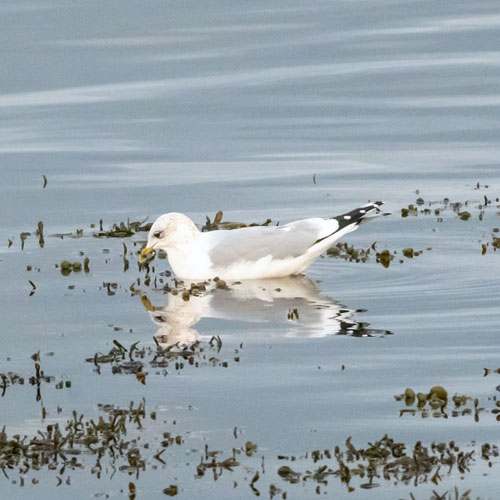 |
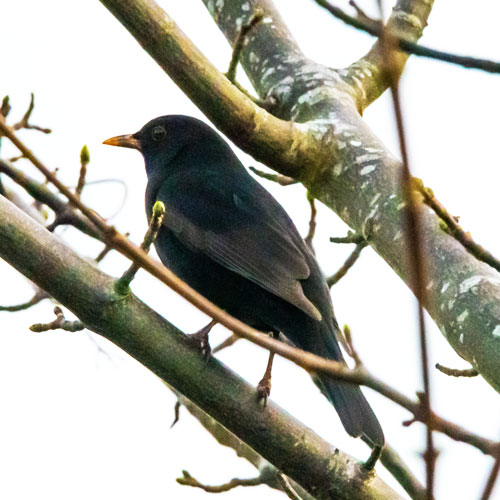 |
| Red-throated Diver |
Wren |
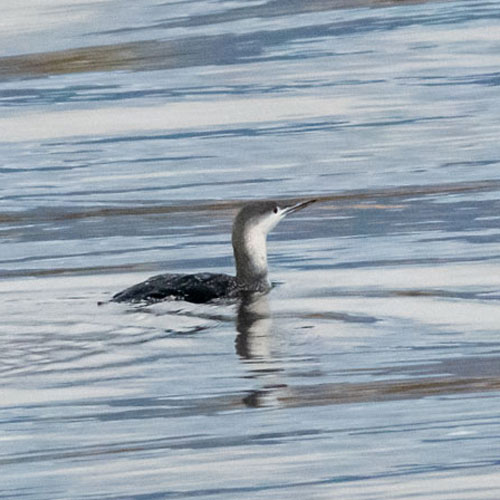 |
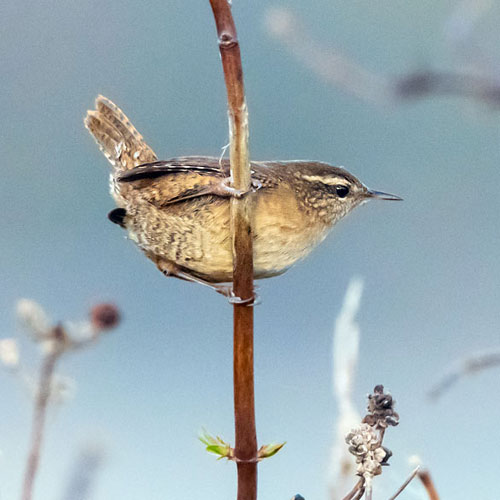 |
Below is the view to the north-east over the Firth of Clyde looking towards the Gare Loch.
We watched an injured Oystercatcher limping across the sands while a close-by Herring Gull was
watching us as it foraged in a seaweed pile. Another Oystercatcher with an opened-up shellfish
scurried away to eat it in peace, away from the competition.
Looking across the bay we noticed that there were around 20 Wigeon dabbling in the middle of
the bay.
We sat for a while to look across the bay where we could see a large number of birds were
gathered including around 30 Shelducks lining the opposite side of the bay.
We resumed our trek and I noticed that some Red Campions were still in bloom. John paused and
trained his bins on “two tiny dots” on the shrubbery. They were Stonechats. The male bird
obligingly positioned himself on top of a Gorse bush. It’s mate was less bold. I then heard the
unmistakable call of a Nuthatch and soon had it in my viewfinder, the first time we’d seen
one at Ardmore. It was moving erratically on heavy, lichen-covered branches on the dark side of a
tall tree, but I managed a few decent-enough shots. Soon after that encounter, from the corner of
my eye I glimpsed yet another first at Ardmore, a Treecreeper, in fact two Treecreepers
searching the moss-laden tree trunk and branches for invertebrates.
| Red Campion |
Stonechat |
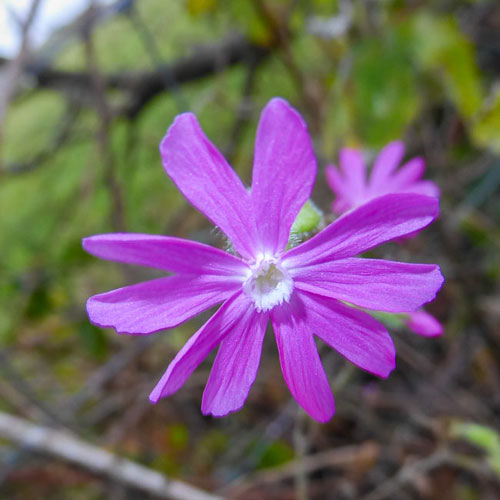 |
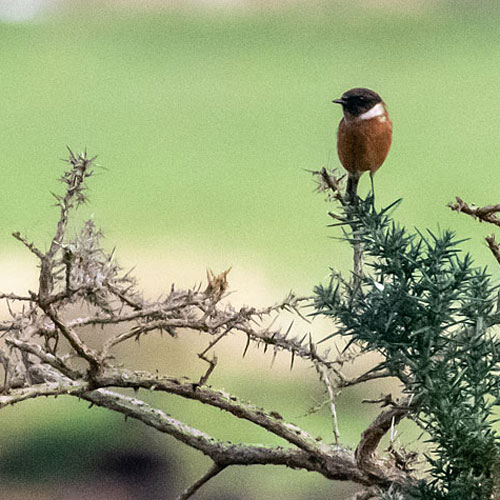 |
| Nuthatch |
Treecreeper |
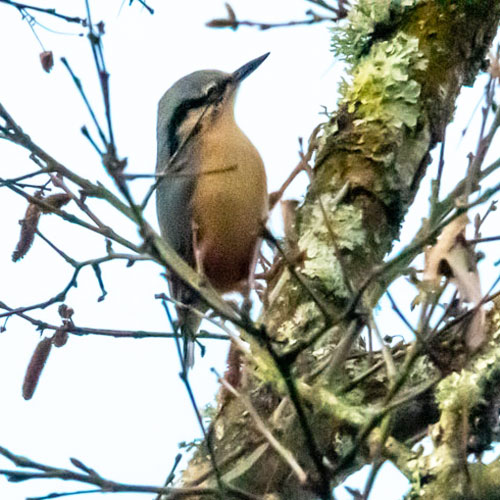 |
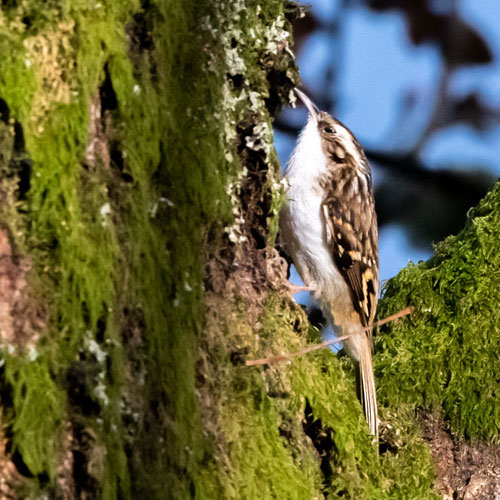 |
Just before we entered the last part of the circuit, which took us away from the North Bay, we
looked back over the Bay to admire the wonderful Autumn panorama.
The final stretch of path was fenced with trees to the right and open fields to the left. I snapped a
female Chaffinch that was hiding in a low bush, followed by a macro shot of Turkeytail
fungus that had sprouted at the base of a tree. John noticed House Sparrow activity near the
paths end, probably due to the feeder we’d photographed at the start of our walk. At first we
thought the cock Sparrow was a Tree Sparrow but it’s head markings were wrong. It was in fact a
House Sparrow. We ended the day with two Corvids - A Rook and a Carrion Crow.
| Female Chaffinch |
Turkeytail |
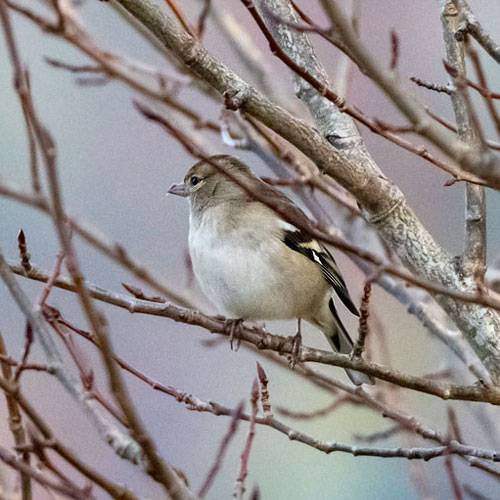 |
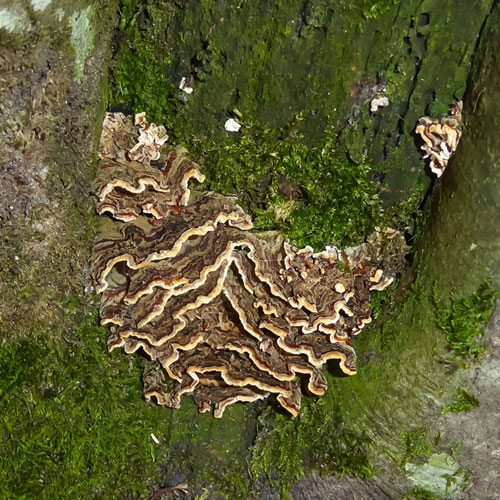 |
| Female House Sparrow |
Male House Sparrow |
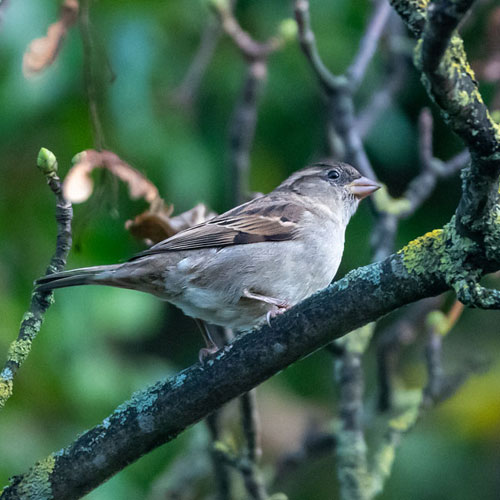 |
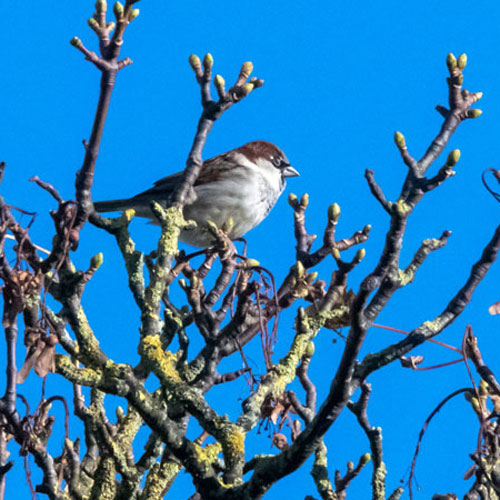 |
| Rook |
Carrion Crow |
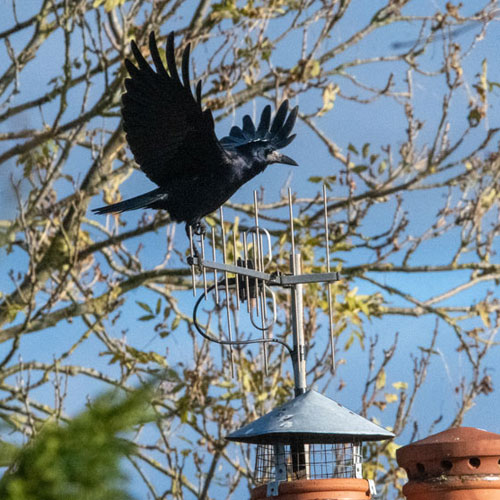 |
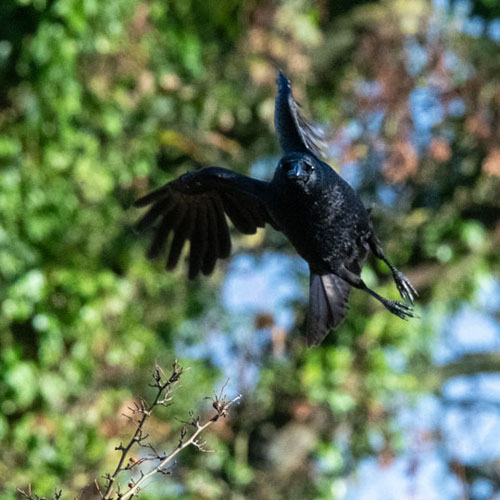 |
We were fortunate that the rain never materialised and the Sun made several lengthy
appearances. We observed 35 species, three of which were new to us at Ardmore - the Little
Egret, Nuthatch and Treecreeper, we celebrated in the usual fashion by consuming strawberry
tarts with strong tea. With a changeable weather forecasted for the whole of next week let’s hope
we are as fortunate next Sunday.
Highlights
- November 2023
We present this month’s gallery of my
favourite pictures I’ve taken during November 2023. They are
not listed in the order they have been taken, but according to a series
of themes. I’ve kept
commentary to a minimum, preferring to let each picture talk for itself.
WAXWINGS
FUNGI 1
PORTRAIT
MAMMALS
BLUE TIT
DUCKS
PARK BIRD
BY THE SEA
LANKY BIRDS
Back To Top
|

